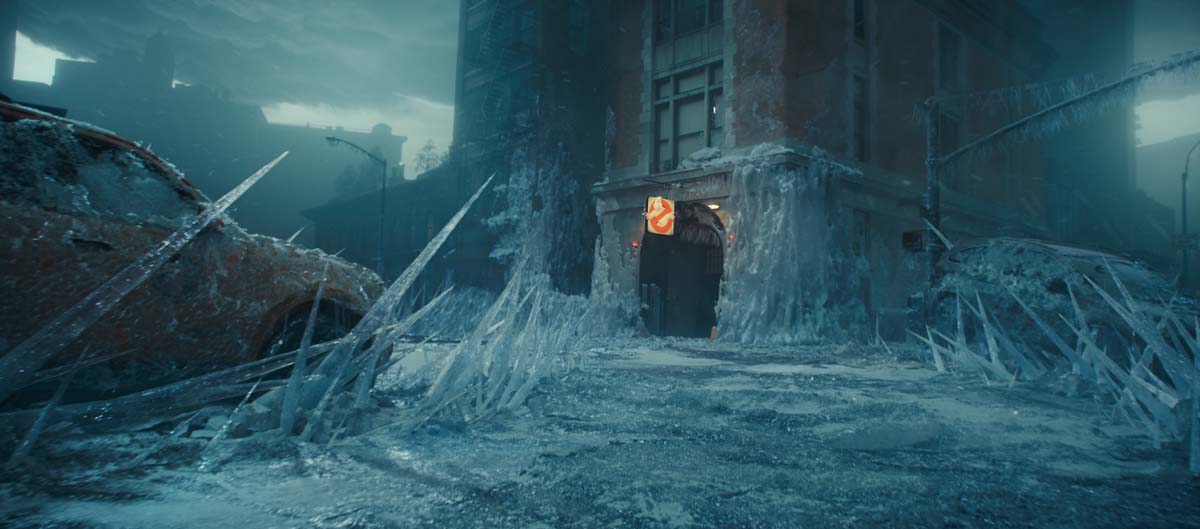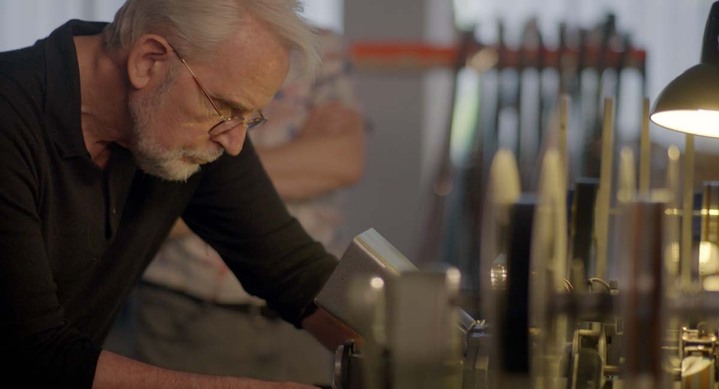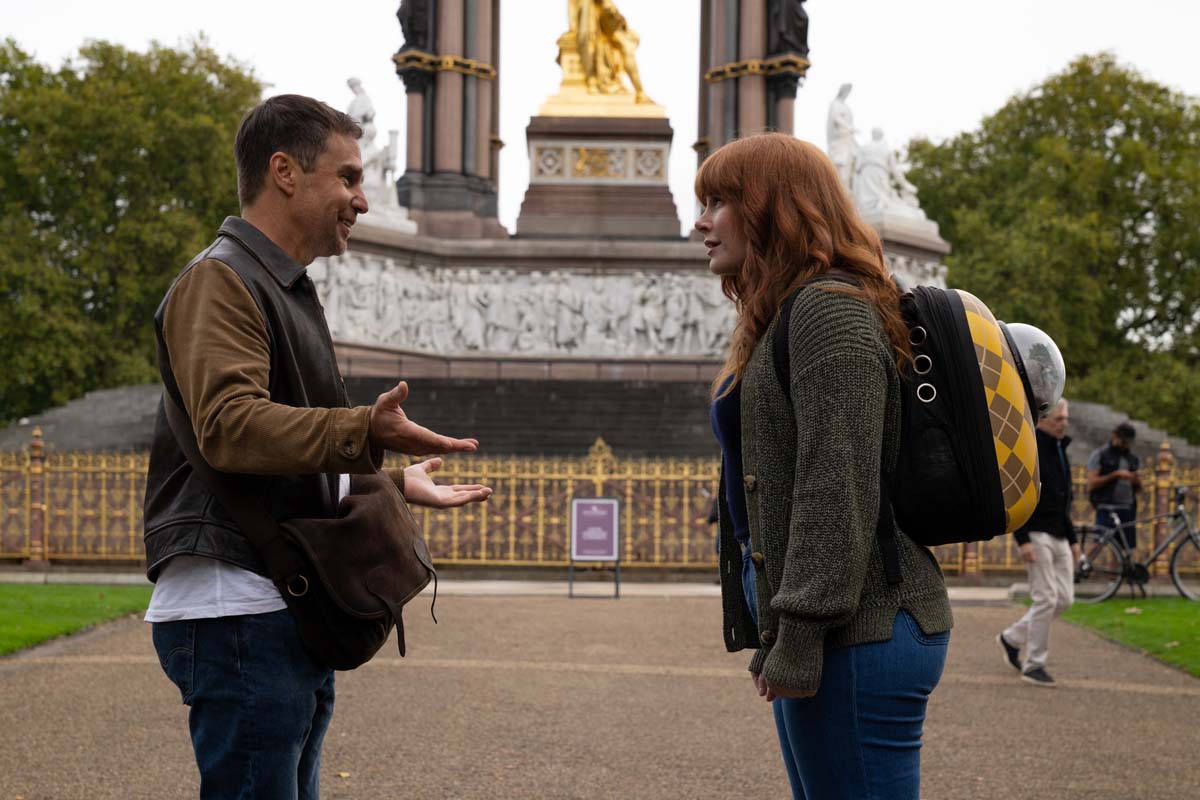The Last of Us
Editors Timothy A. Good, ACE, and Emily Mendez, break down the importance of empathy when editing and how to dial up tension, emotion, and connection through shot selection.
Today we’re talking with two of the editors of the TV series, The Last of Us - Timothy Good, ACE, and Emily Mendez.
Tim edited the feature Dead Man Down and numerous TV series, including The Umbrella Academy, The Resident, and others.
Emily Mendez was an assistant editor on all 9 episodes of The Last of Us and editor for four of them. She was an assistant editor on TV series like The Umbrella Academy and The Resident and an editor on the series Light as a Feather.
Art of the Cut: The Last Of Us
I’d love to start with how both of you started on the show.
GOOD: I got this job very late while they were already filming for several months. I had been trying to get this job for a long time.
I am friends with Craig Mazin through my husband, who's a writer. Craig and his wife would come over with some other writers. We'd have really fun dinner parties at our house and do silly things like make ‘70s food and dare each other to eat them.
Jell-o molds? Or what are we talking about?
GOOD: Oh yeah. With raw vegetables inside. It was called a “celebration salad.” I ate that up. That's how I got the job actually [laughs].
Craig was showing us this trailer for a show he'd done called Chernobyl. I just fell over watching it and said, “I know right now I'm just this guy in serving you drinks, but I'm also an editor.” He said, “Oh yeah, I know your work and I'd love to work with you at any point.”
Three years later, things don't always go as planned scheduling-wise, and all of a sudden, almost everything fell into place. A director that we had worked with on The Umbrella Academy was about to do The Last of Us. He said, “Oh, I want you guys to do it.”
I said, “Well, we've been trying to do it. That would be awesome.” They already had all their editors lined up, but one of them had a scheduling conflict and dropped out. That's when I got the call. I said to Emily, “We might get this Last of Us show.”
Could you explain your relationship to Emily?
GOOD: Emily was my assistant editor at the time and also my co-editor because I had been working with her for a couple of years. Mentorship is a big part of what I do. She and I had been working together on The Resident for a couple of seasons and had just done The Umbrella Academy season three together.
I knew somewhat about The Last of Us, but when I told Emily that we were gonna be potentially doing The Last of Us, she had a different response. And that was...
MENDEZ: I said, “We have to do this! This is my favorite game.” I loved the game. I played it years before and it just felt so surreal that he said, “Well, we might be doing this show called The Last Of Us.” I was like, “The Last of Us?!”
It's always good when you get somebody that has a passion for the project going into it.
MENDEZ: Yeah, exactly.
GOOD: We went into it like that. The first thing that they hand us is episode three, which is the Nick Offerman and Murray Bartlett episode, which sent the internet into a tizzy evidently.
Emily, tell me about your journey from being Tim's assistant to the work that you did on The Last of Us.
MENDEZ: Tim and I have been working together for a few years. During that time, I would co-edit when I could and also just absorb as much information from Tim as I could ‘cause Tim is a wonderful mentor. He allows his assistants to come into his room to sit, to watch him edit.
He explains things really well. He's a teacher and I would just go and hang out in his room when I was done with my stuff for the day and just watch him cut these long surgery scenes on The Resident ‘cause I thought, “How do you do this?” We did that for many years and then, once we were on The Last of Us, Tim knew that I was able to cut and so we started on episode three.
I was able to cut a couple of scenes for that episode. Also, I worked on sound design and all these other things with Craig because Craig is very specific about his sound design. I was already working pretty closely with Craig pretty early on when we were working on The Last of Us, getting the sound design to sound how he wanted.
Eventually, it got to the point where we were working on many episodes back-to-back and Tim needed a little extra help.
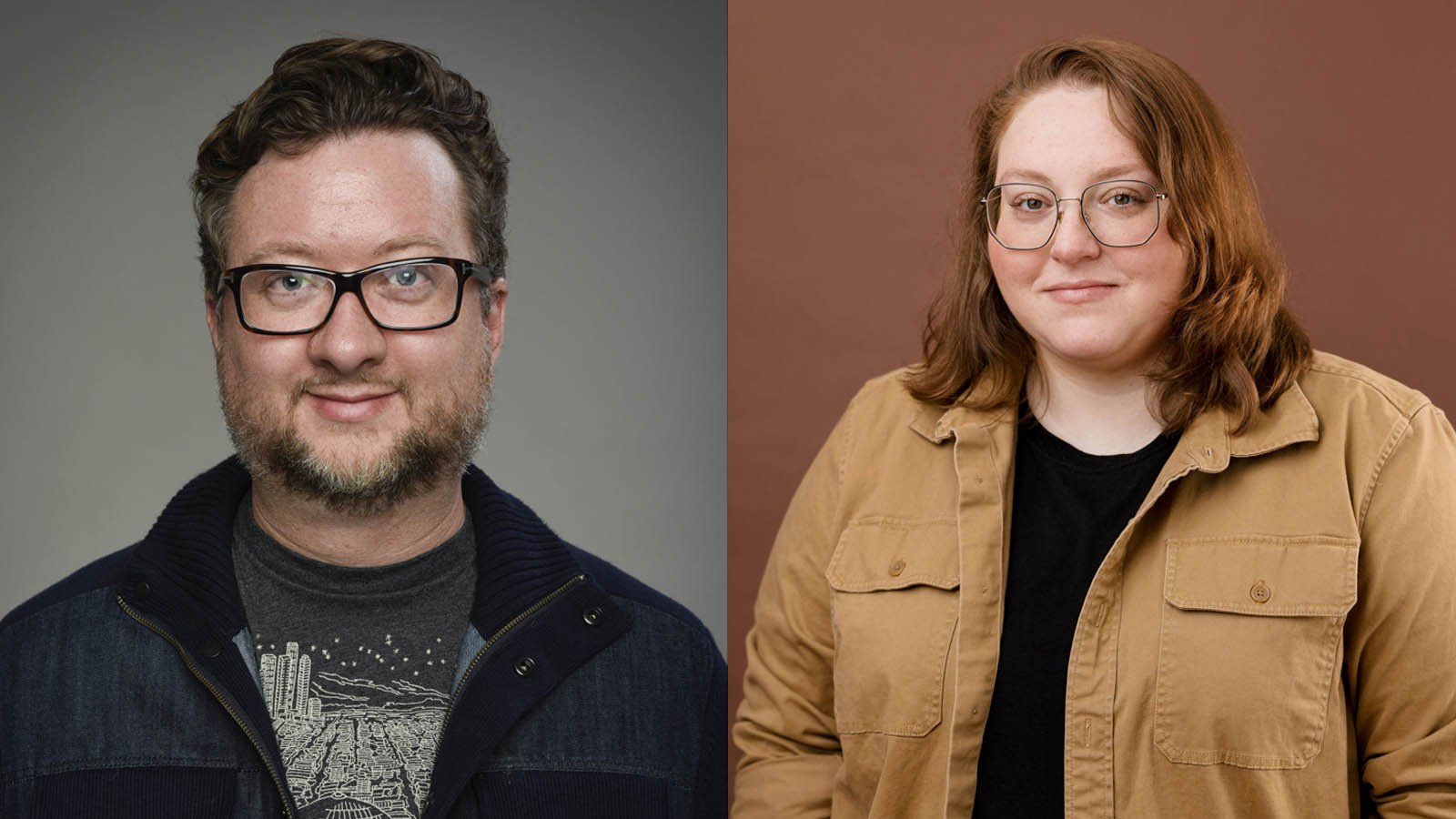 Editors Timothy Good, ACE, and Emily Mendez
Editors Timothy Good, ACE, and Emily Mendez
GOOD: That's when I said, “Okay, I have three episodes going, and he wants me to start a fourth one.” I’m really lucky because, however, this all worked out, my sensibility of what I was doing and what I was bringing to the episodes was what he was looking for.
That was just an amazing dovetailing of styles. Craig said, “I want you to do as many of them as I can get you to do.” At a certain point, there are only so many hours in the day that you can do a great job. You can sure do it. You're just not necessarily gonna do a great job.
Knowing how supportive they have been in general to all of their crew, I said, “I'm gonna take a chance here and risk it because I think that Emily is ready and she's in a position where she can help me.” Also, the story we were about to do was a story about two women who were in love and falling in love together.
I said, “Well, Emily is a lesbian, and she would really understand this in a way that even I, as a gay man, won't have the entire nuances for.” I think for Craig, that was really important to make sure all of these stories had a level of authenticity that he was really going for.
I think between that desire for authenticity and my need for relief, he saw the need to say, “You know what? That's a good idea.” Of course, I promised him that if anything goes wrong, I'll work weekends and nights and fix it all. He says, “Oh, so I'm not really risking anything.”
Of course, I was gratefully correct, and I knew I would be because Emily's an incredible editor and she really just knocked out of the park the first episode we did together. At that point, it became this partnership and every step we took in the future was together and it was really great.
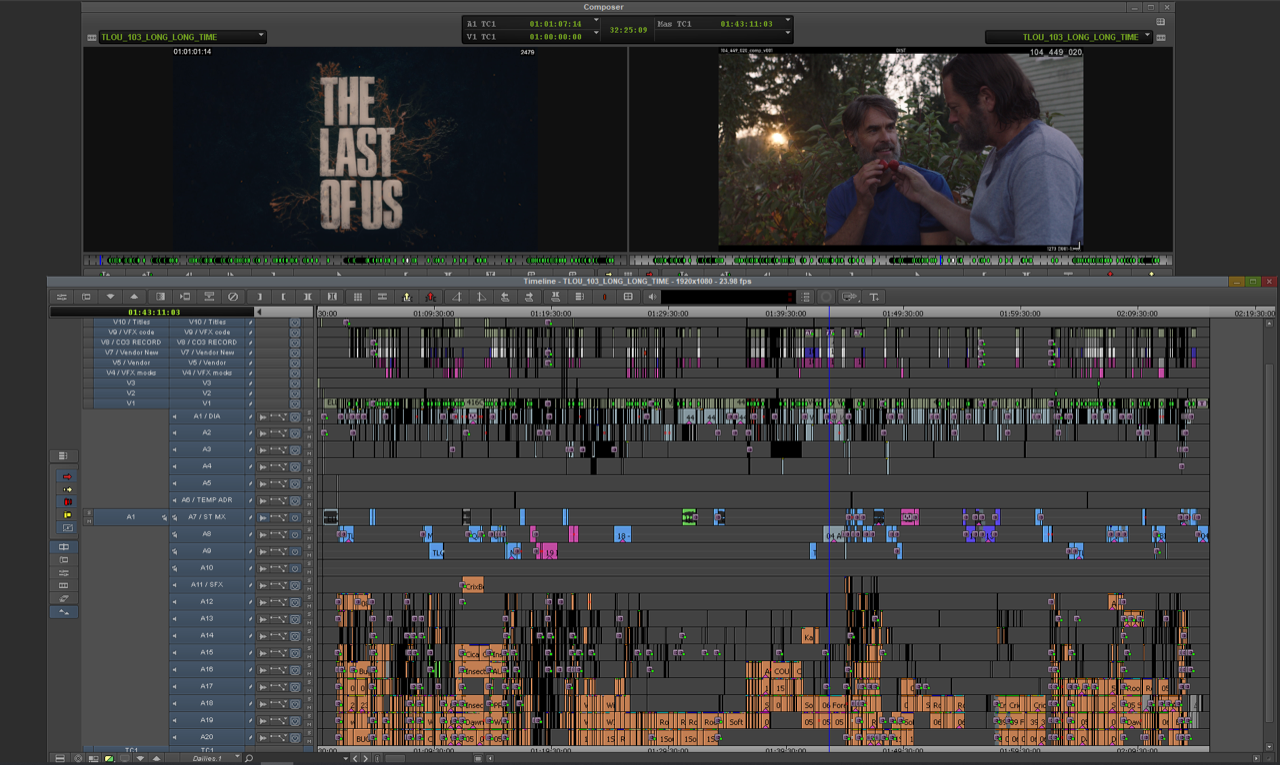 Avid timeline for Episode 3 of "The Last of Us"
Avid timeline for Episode 3 of "The Last of Us"
MENDEZ: Yeah, I'm very lucky that Tim pushed to get me in there from the beginning with co-editing and that he believed in me so much and that Craig allowed that to happen ‘cause that's not something that will always happen on shows. It just was one of those things where the timing worked out and then we just kept doing it together. It was great.
I wanted to talk to you, Emily, about the work that you did with Craig before he allowed you to be on this episode. You mentioned some sound design stuff that you did. Talk to me about gaining his trust, and having him know who you are as a person before you get this opportunity.
MENDEZ: I was just approaching the show as I do with all my work. I was just there doing my best, working and making sure that the sound design from the beginning was in a place where I felt like it was complete. Then, as Craig started listening to it, he would give feedback.
Tim and I are always working to push the story forward, like what is working in sound to go alongside with the story? Craig's notes generally are the same. It's always very story-based. All of us really connect on this love and understanding of story. I felt that from the beginning when Craig was giving notes for sound design.
For instance, in the pilot episode, there's a big plane and Joel and Sarah and Tommy are in their truck. Originally, the temp sound design that I had in there was kind of loud and chaotic - just something that you would expect after a crash.
But when Craig saw it, he said, “All these people have died from this crash. It should be quiet and it should be eerie.” Then, you hear a couple of things here and there and it really changed my whole perspective on my approach to the sound design and what Craig wanted. He likes simple but real sound design.
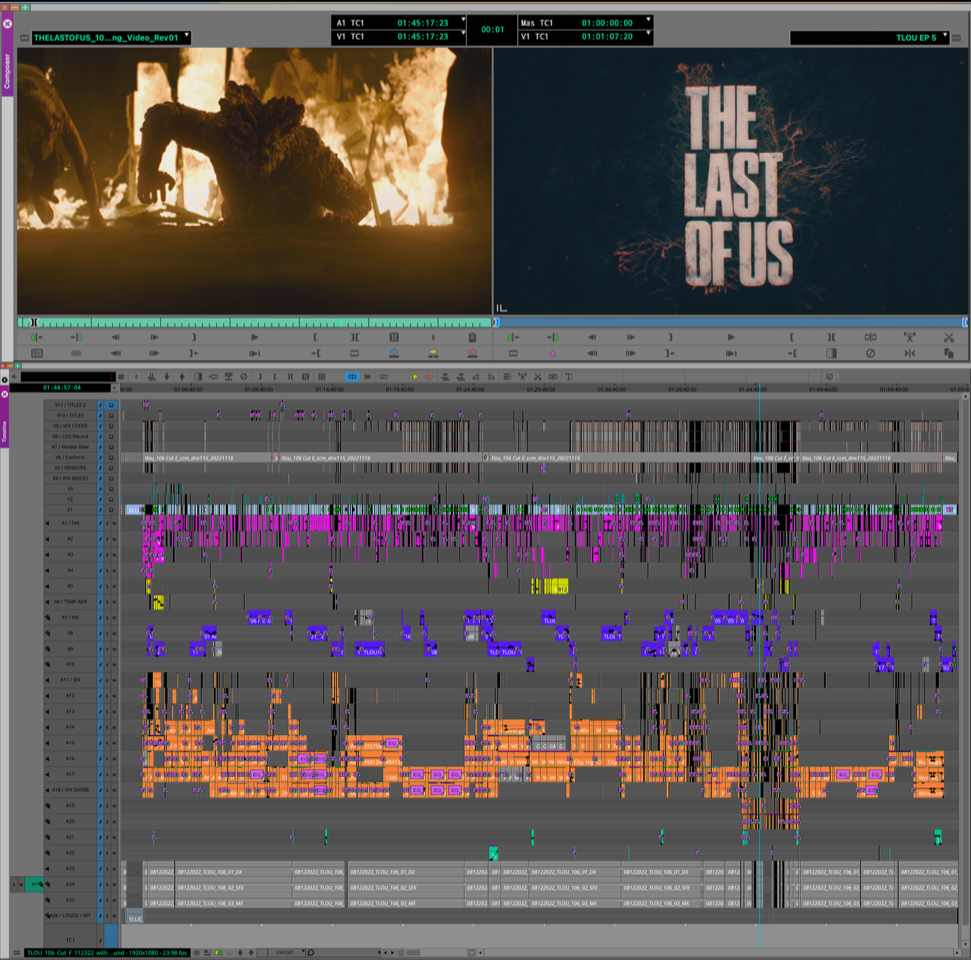 Avid timeline for Episode 5 of "The Last of Us"
Avid timeline for Episode 5 of "The Last of Us"
In a way, I started to really try to approach that scene in that way. As far as growing with Craig, it's just listening. I was just listening to him and trying to put his notes into effect in the cut the best way I could while helping the story. That was how we grew together as a team and started working together.
GOOD: She's being very modest. She's an excellent, excellent sound designer. It's ridiculous. She's one of the best I’ve ever seen. When she was putting these things together, he was saying, “Oh, wow! This is great!” That's why it was working out so well. I have to make sure that the world understands this is not just: “I was throwing in sound effects.”
It was: “I was putting in the right sound effects at all times.” He was recognizing how talented she was and seeing right there, “Oh, this is someone who really has a really deep taste level.”
MENDEZ: Craig and I both love sound design. We genuinely love it. It's such a huge part of it. I love getting a scene and then adding the sound design and then seeing how that scene flourishes from it and what you can do and how much it affects it. It's like the final piece of a puzzle when you're temping stuff and it's just one of those things that I truly enjoy. It did really help us to bond, because we both share that.
Can you think of an example about sound really affecting a scene? Other than the great one you gave of the plane crash, but maybe even specific sounds in that scene?
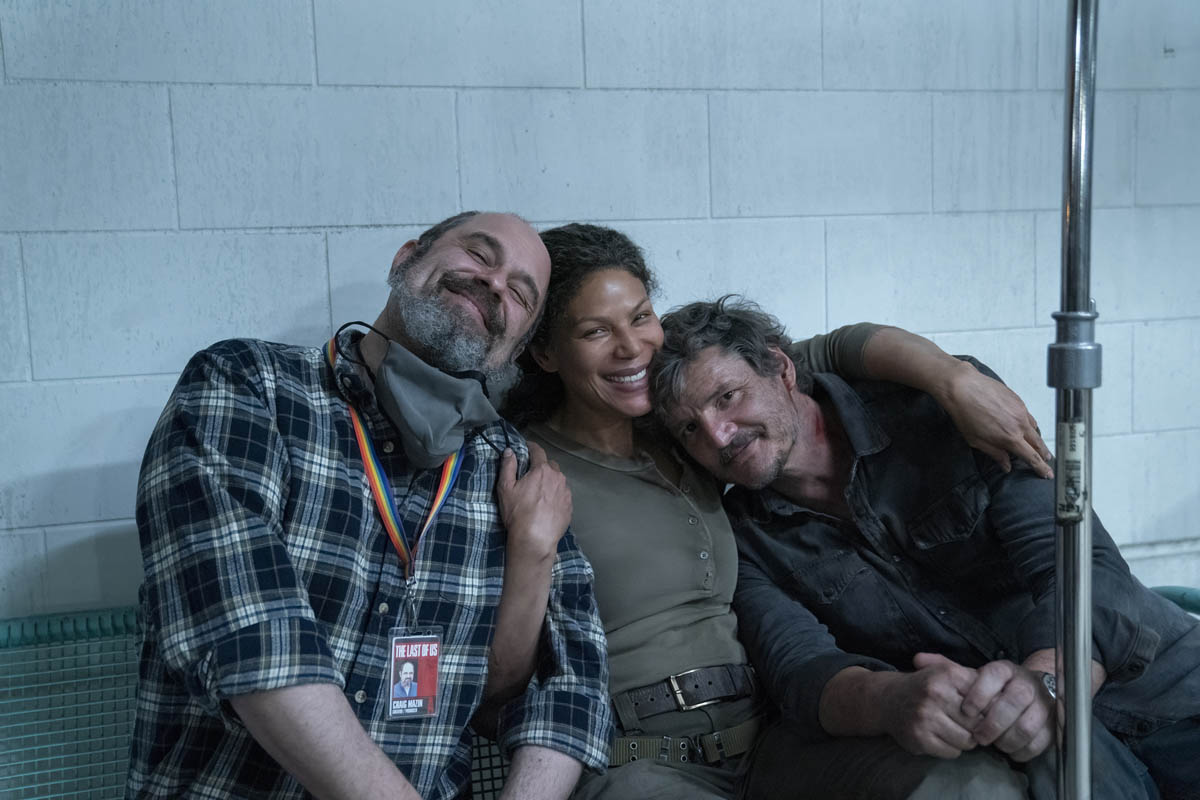 Showrunner Craig Mazin, Merle Dandridge, and Pedro Pascal
Showrunner Craig Mazin, Merle Dandridge, and Pedro Pascal
MENDEZ: In that specific scene, the thing that I think is really cool is we were very specific about what sounds we were hearing, so you would hear maybe an infected in the distance. We were playing with perspective where they are in the town and then they're hearing things that are scary that are farther away.
It's disorienting. They're disoriented and they don't really know what's going on, but you're hearing infected, but you're maybe hearing a gunshot or is it a transformer? You don't know exactly what you're hearing. In a way, I think it adds to that fear and that scene and it really gives it that eerie feeling of, what is going on? Where am I? How do I get out of this place? I think it really was effective in that way.
GOOD: What was really fun to do sound-wise — and this was a plan that Emily and I hatched together on the final episode — was during the massacre in the hospital. If you're playing the game, perhaps you would do it where you'd hear all the gunshots and you would feel a sort of a battle sequence kind of feeling, which we had done in episode five that had already been done with the bloater and all that stuff.
But this was a sequence where sound had to take a backseat. Craig had said, “This is not a scene about action. This is a scene about emotion, even though it's an action scene.” I said, “Well, Emily, what if we were to play with how we hear the real world and how much we hear what is internal to Joel?”
We picked a musical track that would go against what we would expect, which was a very emotional, evocative, operatic piece of music that played against what was actually happening on the screen, which was this sort of massacre. He's taking everyone down.
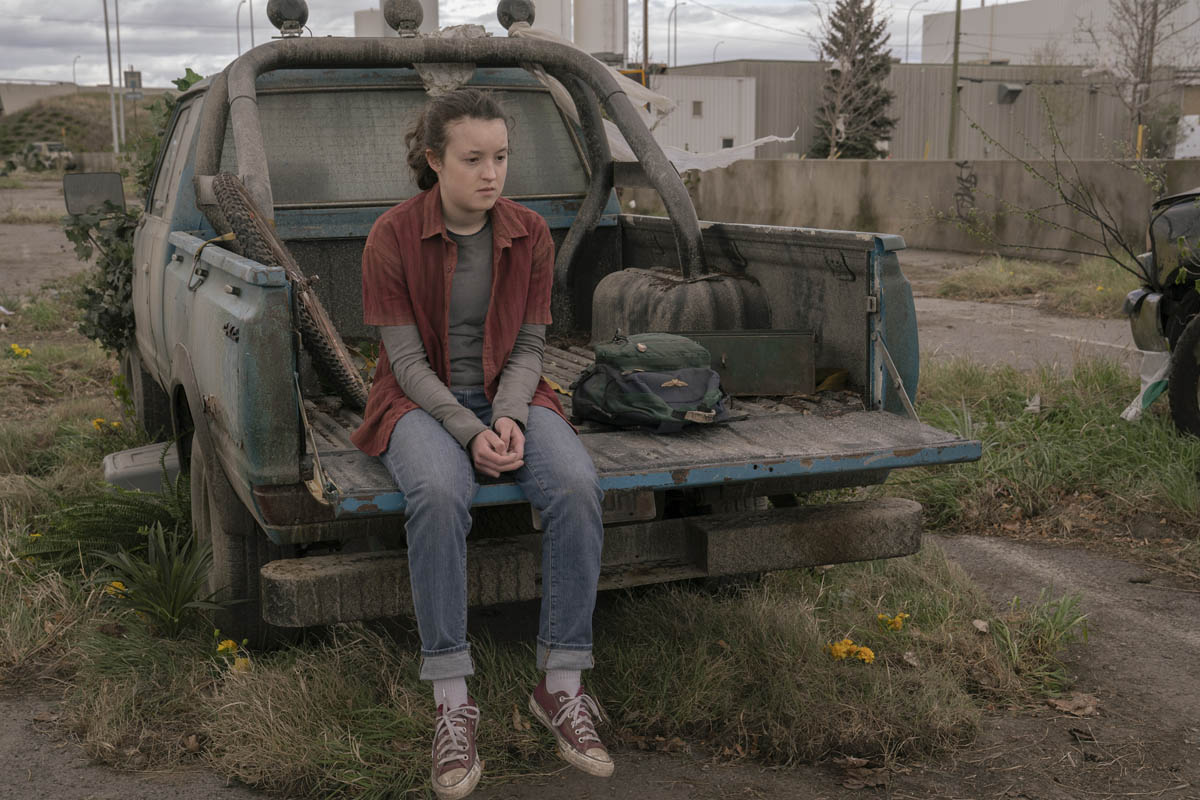
But I feel it was really effective in helping the audience to connect with the internalized rage that he was feeling and how he really wanted desperately to get Ellie back, this person who he pretended he would never love. He thought, “We'll keep our histories to ourselves,” et cetera, et cetera.
But ultimately, at a certain point, his parental instincts just cannot be stopped. He has to do anything it takes to get her back. I felt like that would get into his mind in the most effective manner. Also, because you make these things and there are lots of loud sounds, it's hard for you to emotionally connect.
The more muted the soundtrack became and the more amorphous and ethereal it felt, the more emotionally connected I feel that the audience became to Joel because there was just not a lot of volume to the soundtrack as it were.
There's something about doing those things that go against all the expectations that I just love doing. I just feel like that's the kind of stuff that makes the job of editing so much fun.
When you handed off that one episode to Emily, you felt like she would understand the characters. And you edited episode three, which was about two gay men.
Let's talk about empathy a little bit and why you saw that as a value in what Emily was gonna do and why it was a value for you.
GOOD: Ultimately, empathy is what I think makes editors spectacular. It's not a technical job. It's a psychological, emotional job. The more you connect to the people that you're looking at and the characters that you're trying to show the audience, you want the audience to connect with these people, whether or not they're, good people necessarily or bad people.
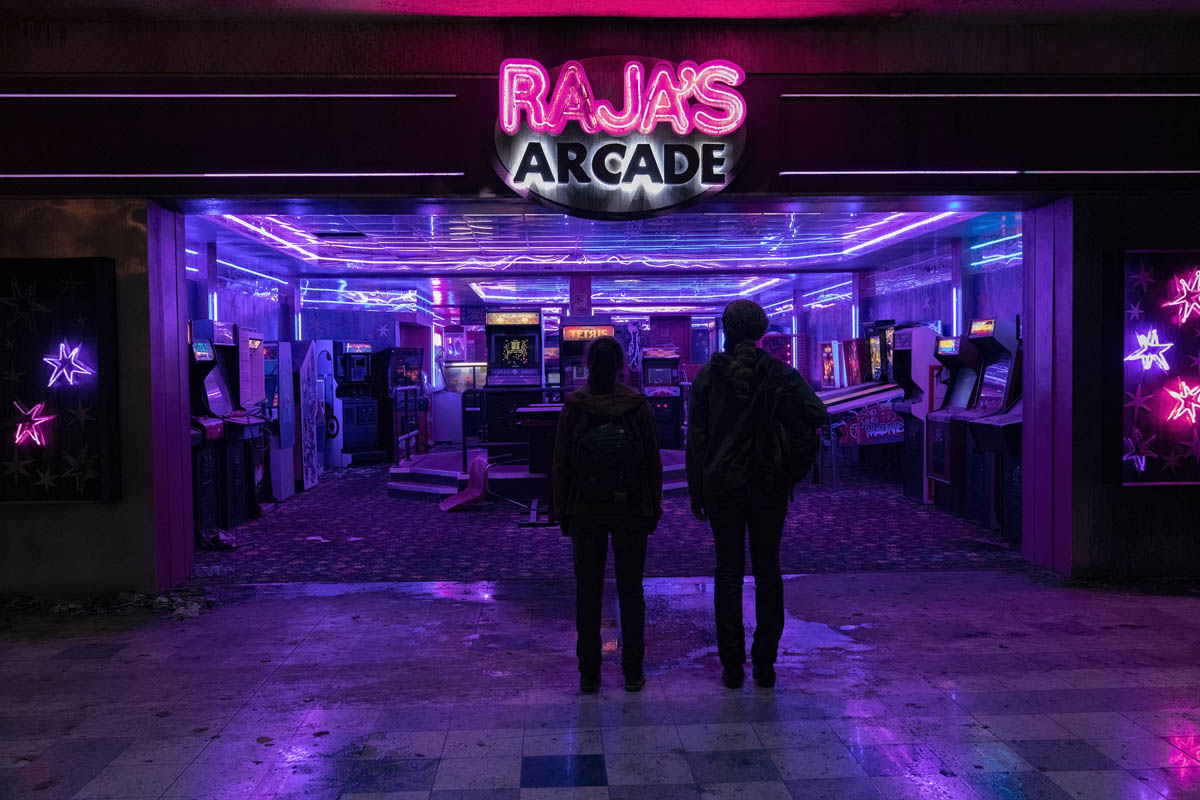
They may be bad, but they also should be relatable. You have to understand them. Everything I do comes from a place of: why are they doing what they're doing and how can I see what they're doing? And how could I show the audience why they're doing what they're doing?
I feel tremendous empathy for the characters of Bill and Frank. As a gay man, it was easy for me to connect, maybe a little bit more so because I understood the secret language that has to happen between two men that may not have to happen between a man and a woman when you're first meeting and you're starting to sort of suss each other out.
That helped me find little nuances that maybe someone who's not a person in this community would. That was the thing that helped me in episode three and I know for sure helped Emily in episode seven with the story of Ellie and Riley.
It’s a similar thing but also between two women in their teenage years, I just didn't have that experience. I don't know what that experience feels like. Emily said, “Trust me, I do.” Therefore, I thought, “Yes, this is gonna be the right thing.”
But again, your question is about empathy and you're a hundred percent right. It's really about having an understanding of what human characters just want. What they want ultimately is to feel needed, to feel enveloped in love.
They want to live a successful life and what that successful life looks like is a life where you feel that you have a purpose. In that way, the episode with Bill and Frank was really easy to create empathy for ‘cause it was really about everyone. Craig Mazin, who's a straight man, wrote this and said, “I wrote this about these two people and I wanted to show in a way my relationship with my wife.”
It's no different. It's this story of longevity and a story of commitment. To empathize with these characters who make a commitment to each other is just a beautiful thing to be able to put together. It really is.

MENDEZ: That was definitely an experience that I had been through growing up, falling in love with your best friend and not knowing if they feel the same. I think I was truly able to pull from my experience to get pieces into the cut that, to me, felt real. But ultimately, even if I hadn't experienced that, Tim and I are always watching through every piece of footage and we're always marking up everything we see.
For me, when I'm marking up dailies, if I see a moment in a character where it feels real to me or I feel some kind of emotion, I will always mark it and I'll try to get into the cut because we are trying to incorporate that empathy into our scenes if it calls for it. But we're also just trying to make our characters feel real and support them, ‘cause the whole thing that we're doing in our jobs is to just bring to life these beautiful characters that Craig has written on the page. Then, our great actors have brought to life. We're very lucky that we have such talented actors that gave us so much to work with in these episodes.
Bella and Storm in the “Left Behind” episode just gave us so much to work with. When I was watching those dailies, I was feeling — before I even had the scenes together, I was thinking - this is just great. I loved every second of it. It just was pulling those little pieces together that were just real to me, that make my heart feel something. It's just a feeling I get when I'm working. That's how I do it. That's how I put together that empathy and that feeling.
But then there's also that overall empathy. Like neither one of you has been fathers to a daughter that died or something, and yet you're able to cut those scenes too.
** SPOILER ALERT **
MENDEZ: Exactly.
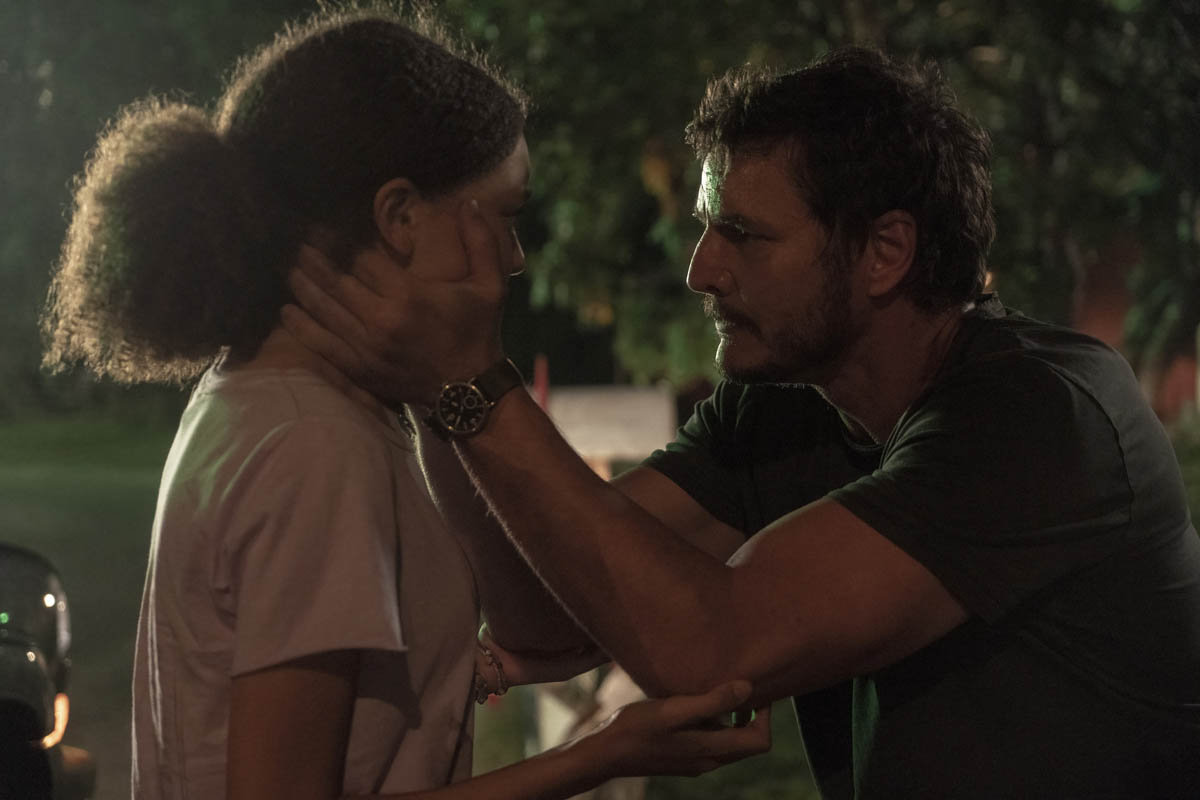
GOOD: Hundred percent. That's absolutely correct. It's connecting to another human being. Even just seeing the two of them talk — the final episode about his suicide attempt and him opening up to her — it was about her understanding that he's finally releasing himself to her and saying, “I'm going to trust you.”
For me to understand and decode what that moment is about an understanding of the trust between a daughter and a father in a way that maybe I would understand between my dad and myself. I looked at it from the Ellie perspective and saw it in that way.
** END SPOILER ALERT **
One of the other things I heard Emily say — which I loved her fearlessness in talking about it - ‘cause it happens to all of us — is she went for what she thought was the right idea of putting this plane crash audio together. Probably was fantastic and sounded great, but not what Craig wanted. Talk to me a little bit about ego and being able to say, “Oh, well, I didn't fail. I just didn't have his idea.” Talk to me a little bit about taking a note, for example.
MENDEZ: Sure. Tim sets this great standard where he is always open to notes from anyone. He'll invite people into his room, play a scene, and ask people how they feel. He has included me in that since I was very early on an assistant for him.
Before I was his assistant, we knew each other for a couple of years. We were both on the same show, just not working directly together. He would call me into his room then, so he's always set this standard of, notes are not a bad thing. It's a collaborative effort and both of us have this same feeling.
It's all about collaboration. It's all about getting the story to where it needs to go. So for us, or at least for me, when I'm getting notes, I'm always looking at it as this is the new directive and this is the new kind of ever-evolving puzzle in a way.
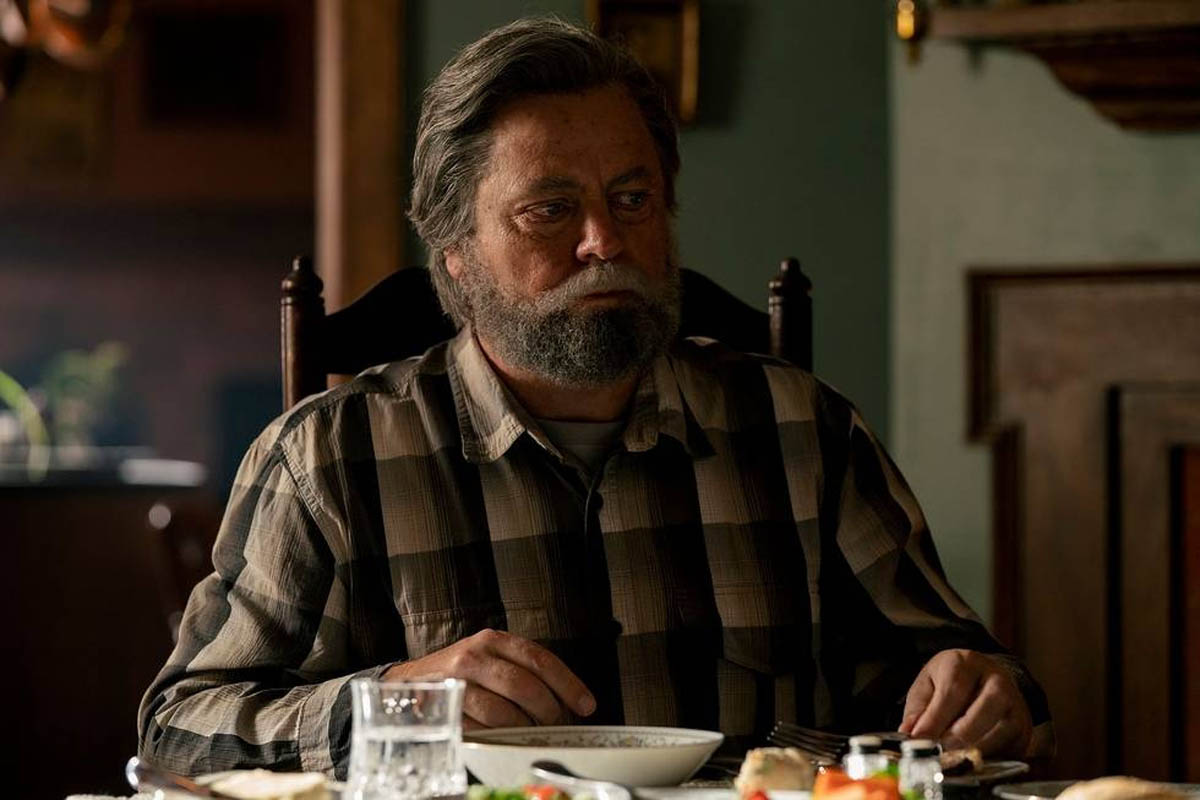
I'm always trying to get the scene to how Craig wants it or whoever is giving the note so it can be the best it can be because we put a scene together in our first pass. It's not going to be exactly how it is in the end. That's just the way it's gonna be. I feel it's a much easier route to just be open and to accept these notes and to take 'em as a good thing.
That's the only way the story is really gonna get to a place where it can shine ‘cause sometimes, we don't get it in the first pass and that's okay.
GOOD: The thing about notes is: anytime I've worked something more so than a normal editor's cut, it's gotten better. I say, “How can it not get better?” We just have to keep working with it and new discoveries are gonna happen.
If you just accept it as functional, then it may not reach its full potential. I learned that early on when I was mentored myself, where I was being told to keep making changes because the whole process is about making adjustments and then, at a certain point, you're gonna say, “Alright, this one's done. We've really got to the place we should be at. Now, we're really good. We've gone through every iteration and we've landed on the thing that works the best.”
If you don't do that — and I've seen a lot of people who say, “Oh, this is exactly how I did it the first time” — well, yay, but my ego is not about that. My ego is about, is the story affecting people in the world? If the story affects people in the world, then I'm happy. It's my great joy to have people respond in a way that says, “Hey, this really helped me talk to my mom about some stuff. This really helped me talk to this person. I heard from my father for the first time in a long time.”
That's the joy that I think we get out of these things. Editors are very emotional people and we want to see our work recognized. This is the way that it gets recognized and it's a beautiful way. People around the world will say, “You created these moments and these connections and these stories that really helped us all see our families and friends in a different way.”
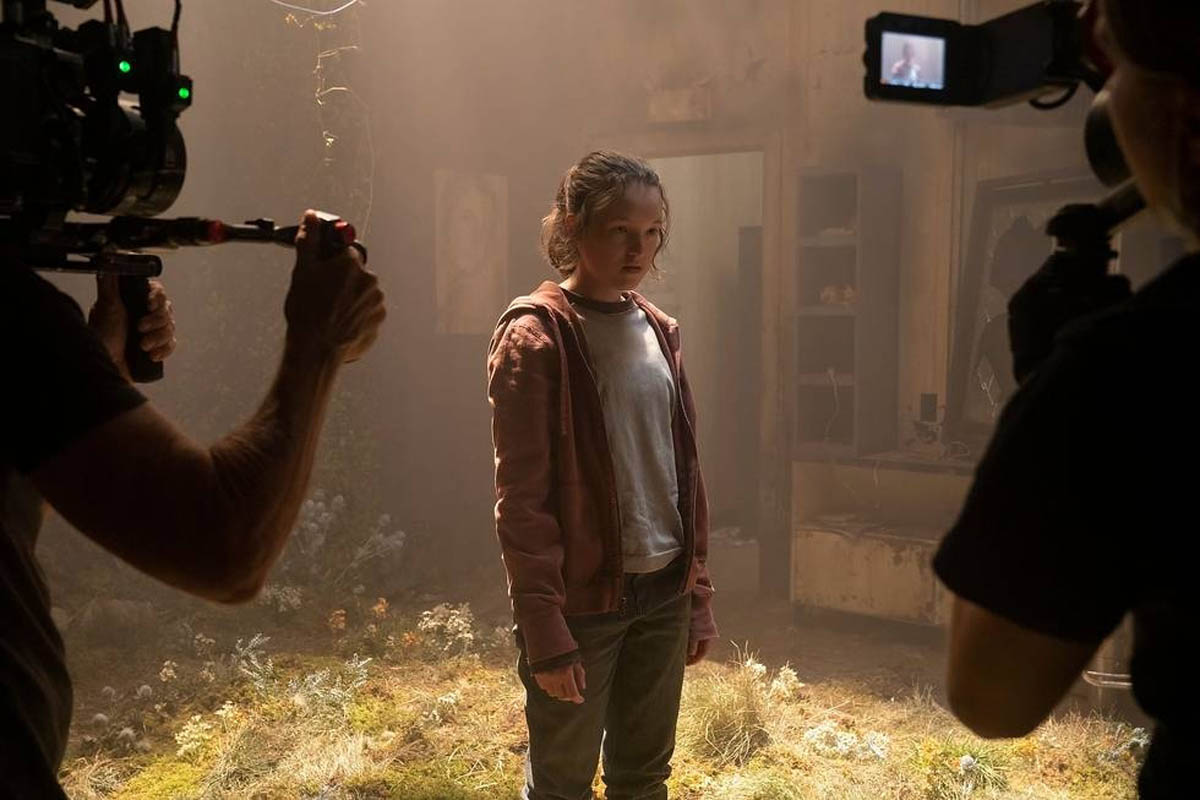
Let's talk about the idea that Emily mentioned about seeing truth in performances and just as you're going through dailies, either how you note that, how you find it, and how you use it, those moments of truth.
GOOD: We have a methodology. We have this weird locator system. We call 'em: The Colors. Each color has got a different heat map to it, as it were. A green locator is a good thing and you definitely want to get a green locator.
A green locator means, “Hey, that really hit me. That was a good moment. That could be useful.” “Could be” is the operating word. Then, once in a while, when something comes along that we look at and say, “Oh my God, that is incredible. Stunning. It must be in. It is in the film,” we put down a magenta marker.
We will put that down and basically say, “This has to make it in. There's no way.” If we go back to this daily and I see a magenta marker and I cut it in and it's not been in there, I say to myself, “What are you thinking?”
Because this was the thing that you saw the very first time around and it affected you in such a way that you said, “This is magnificent.” Again, editors all know this, but we only see things with a fresh eye once. You can only approximate the feeling you get.
A lot of times, what I'll do is, when creating and using these moments of truth is let's just sort of cut the scene and see how many green locators show up in the scene. They say, “Oh, there's a couple of them. Cool.”
As you're doing notes and changes, you use those green locators and you sort of replay them again and you see if there's anything in them that now functions. It’s like replaying a camera roll and seeing things new again and saying, “Oh, fresh perspective.”
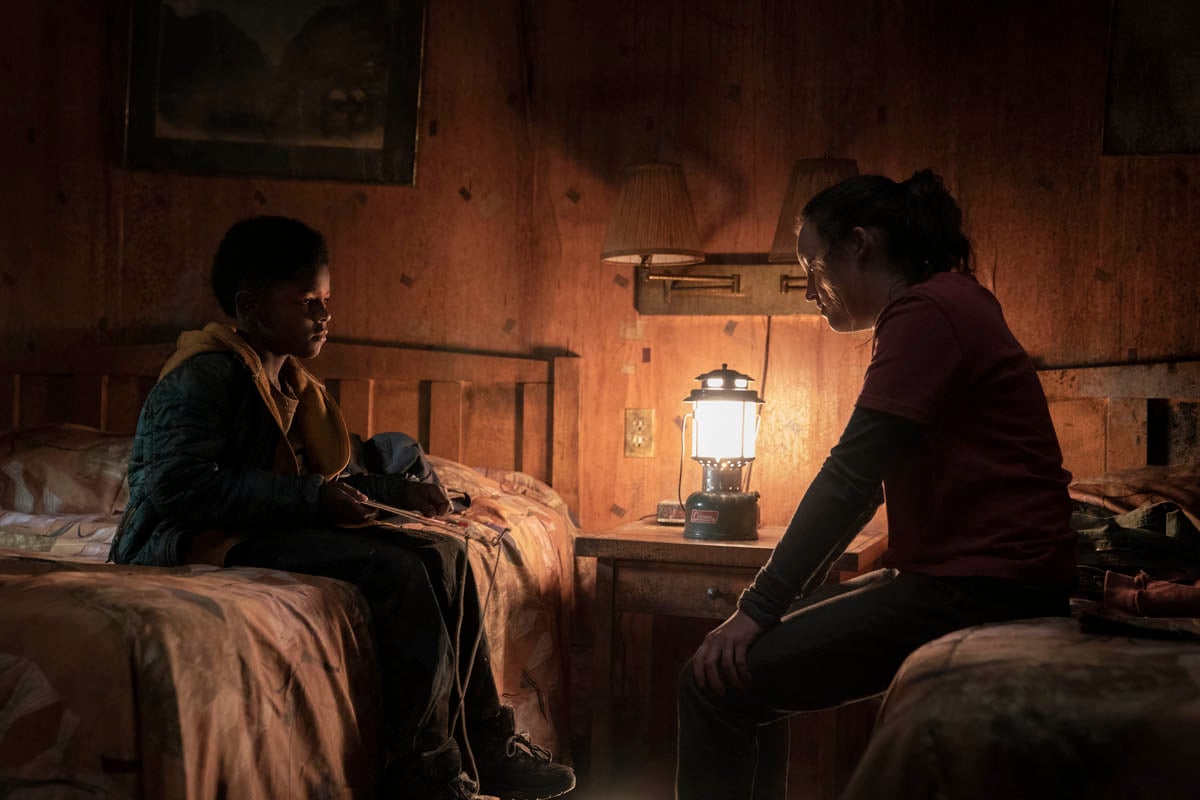
It's a way to sneakily go through and just sort of see as many of the reactions that you had marked in the beginning. Obviously, you can still watch it all over again, but this is a way to go through very efficiently and find those things. Of course, if there's that magenta marker that you see and you say, “Why is this on in there?”
There may have been a magenta marker that was better and that does happen sometimes. You say, “I guess that one trumps this one.” But that's how I would generally approach it. It's knowing that those moments of truth exist in the dailies that we put a little bell on.
As you're going through and building the scene and you'll see these little green markers and say, “Oh, there's another one. There's another one. That's right, that's right. I remember this one.” It is a snowball effect of good things that happen. That's kind of how I do it.
MENDEZ: I totally use your same methodology because I think it's great and it's helped me many times. I also love how excited we get about the magenta markers. It's stuff that we mark for ourselves to remind ourselves to use it. I actually have an example where I didn't use the magenta marker, which was when we have the character Anna, who's Ellie's mother, and she's just given birth to Ellie.
Originally, that scene was a little shorter when she first says hi to Ellie. When Craig first watched the scene, he said he wanted there to be a longer moment between Anna and Ellie of her taking in this joy of this baby.
When I looked back at the dailies, I had two magenta markers that I had not used and I put both of those pieces in. One was the shot of the little baby’s feet by the jacket. Then, I think another one was the little hands, these little tiny cuteness moments where they made my heart feel something.
They got the magenta marker and both of those I put into the second pass of this cut. Then, Craig loved it. I said, “Why didn't I have my magenta markers in from the beginning?” Tim's saying, “You're watching the dailies for the first time. It's your best way of marking like, ‘This made me feel a certain way.’”

GOOD: There's a blue locator that's if there's a B camera. I wanna differentiate if it's in a group clip. If it's a B camera, then I'll watch separately. Or if it's a C camera, it's a yellow marker. I can tell right away, flip to the other camera, that's where it was.
Because you're looking at multi-cam footage, but you might not be looking at the right angle.
GOOD: That's correct. It's usually all grouped together. I'm one of those strange editors who can't work with a very crowded bin. I just can't do it. There’s too many frames. I freak out. I keep everything in groups and I just say, “I know how many cameras are in this one.”
I just mark individual, one-time multiple colors, and then I use that, multi-group clip as the one I use forever.
I definitely do markers on things I think are great, but also my assistants, it's a marker on the slate, marker on action, marker on cut, and also markers on resets.
GOOD: Resets, for sure. We got those too. We got red for action, yellow is for restart, or red is reaction. It's a crowded house of color.
Let's talk a little bit about special effects. When you were trying to tell the story during dailies, what were you doing to either imagine or use previs or slates or what did you have to do to build some of those very heavy VFX scenes?
GOOD: We were lucky. We have an amazing team and the way Craig wanted everyone to work is we were all working in an office, together. So the visual effects department was with us. The visual effects department was a huge part of this production. It was a massive department. There were 14 people that were just hanging out with post-production.
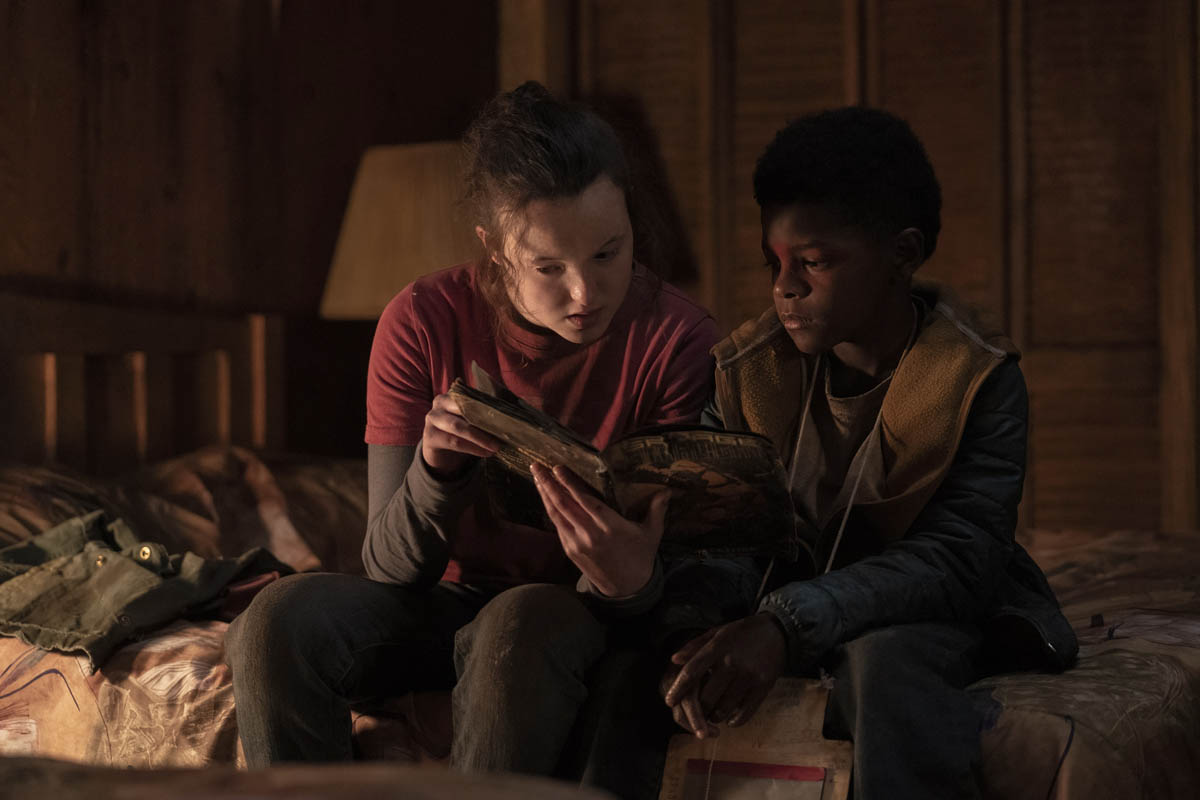
That was fantastic. We really were able to interface. We had a wonderful visual effects editor, Luke Botteron, and interfaced with him all the time when we had things that we’d say, “Oh, here's a plate. Do you know if there's any previs coming in with this?” He’d say, “Oh, yeah, I have previs for that. Let me take that from you. I'll put this behind these shots, et cetera.”
I'd have a scene together and I say, “I'm not sure what's supposed to go behind here.” I could talk to Alex Wong, our visual effects supervisor, ‘cause he's right next door. I say, “Alex, what goes behind here? What are we looking for and how many shots are we budgeting for here? How can I blow past that budget?”
He would just look at me like, come on. But no, seriously, they were really instrumental in helping guide us through it because we had so much on our plate that it was hard for us to even focus on all of the things that were flying around.
We had basically seven hours of stuff going in our head at all times, or eight hours, I should say. Having them nearby really just allowed us to have temporary materials that were put in all the time. They had an enormous amount of support staff with them that would do that for us so that we had something to show.
We had something that had some sort of story happening that you could actually understand. It wasn't perfect, of course, but luckily, we work with people who understand that perfect comes later and they can tell the story through rudimentary temp visuals and whatnot.
How many of the infected scenes - the fight or chase scenes - were prosthetics? How many of them were pure 3D?
GOOD: They had a huge prosthetics team, led by Barry Gower, who's the one who did all the Game of Thrones stuff. A lot of it was prosthetics. Craig and Neil Druckmann, the co-creator of the show, really wanted to utilize as much prosthetic as possible with VFX enhancement.
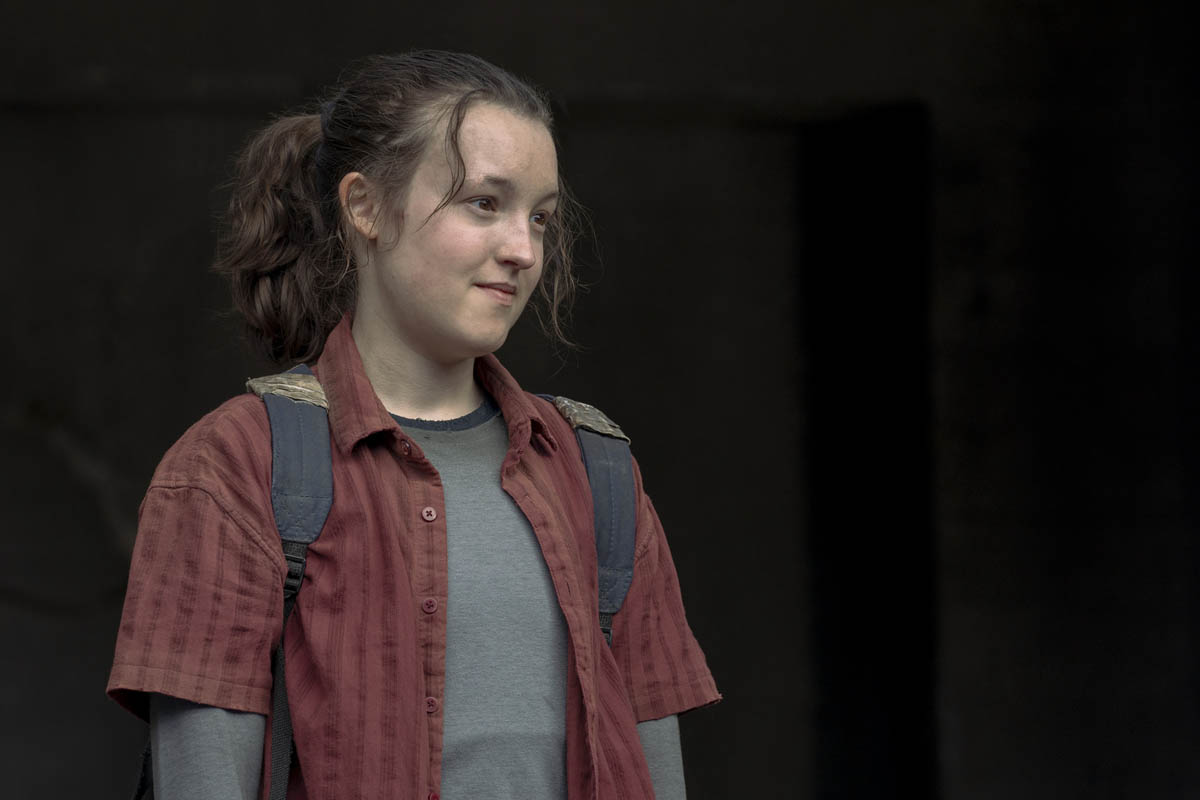
In the third episode, when Ellie kills the infected underneath the Cumberland Farms, that infected was fully prosthetic except his right eye had a little green marker over the eye ‘cause they knew they were gonna do something with visual effects.
A company in Norway called Storm Studios actually took just a section of it and created this fungal bloom out of the eye. It was so real-looking that everyone was shocked at how real it looked.
I think the reality of it is achieved because we were blending prosthetics with visual effects. There was a sense of texture that was being brought along that it wasn't all fake. You had this semblance of realism. Then, there was just a little portion of it that was enhanced.
They enhanced a few other things on those shots as well, but that was one of the things that made, I believe, the infected sequences look so scary because it was partially real. The one character that is all CG is the bloater character in episode five.
They created the full bloater suit and they actually had the guy in the suit for all the dailies of the sequences because wisely, they understood that it’s hard for these people who are being attacked by this character to react in a natural way without something actually there, not just like a little tennis ball chasing them. They had this huge British bodybuilder in this suit and he was running at them, so they actually were scared.
It allowed the visual effects department to scan the suit that Barry Gower and his team had created and allowed them so much more detail in the intricacies and the anomalies of the suit, so it wasn't this perfect thing. When you see that character in the show, you can't really believe it's CGI. It feels like it's real.
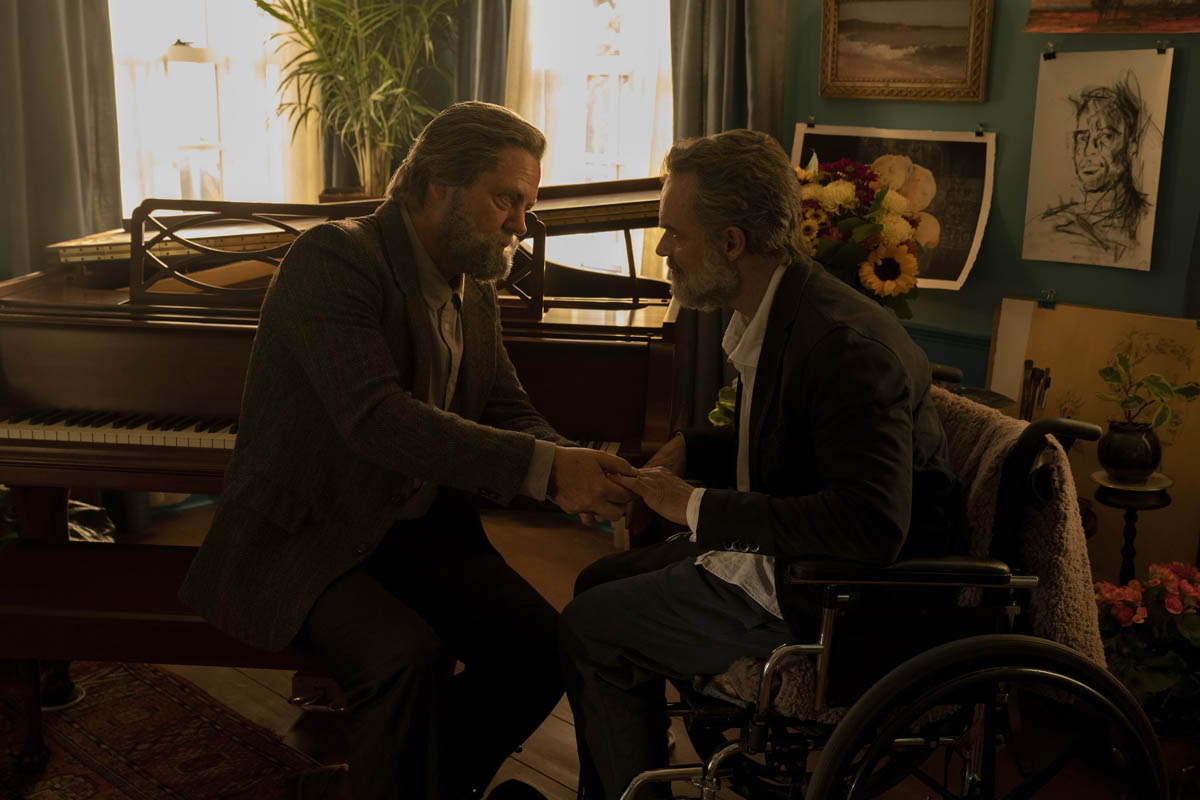
It's mostly because they did a whole pass of it with a real prosthetic and then they swapped out for the plates at the end. People were much more fearful and the ability to see how the firelight would play off the prosthetic allowed visual effects to do a better job of integrating the character. All of those things helped to create a CGI character that just was seamlessly integrated.
That was done in just some of the takes and not all of them?
GOOD: It was all of them. They really had this bodybuilder. They made him work out for it. He was in all of 'em. They only did the little plates at the very end. That was that. I was just using the plates for the character to be inserted later, but he was doing all the work and the body of the scenes.
For a tech geek question, when you did that, you were cutting with the bodybuilder and then carrying the plate underneath on a track?
GOOD: Yep, that's exactly right. Then, when the time came, the plate would be turned over and then we would get an animation back from Wētā. That animation would then be cut in and then I'd recreate the edit with the animation. But yes, it was tricky to do at first because we had to use the prosthetic for people to understand what was gonna actually happen.
But we also knew that the prosthetic was gonna be enhanced a thousand percent. So of course, I would do little tricks like speed up here and there, take frames out to try and give it a little bit more of an offensive, otherworldly inhuman, just in the process of trying to just sell the sequence, but we always knew that it was gonna be a plate show. It was kind of fun to watch that version too because it was like, “There's nobody there!”
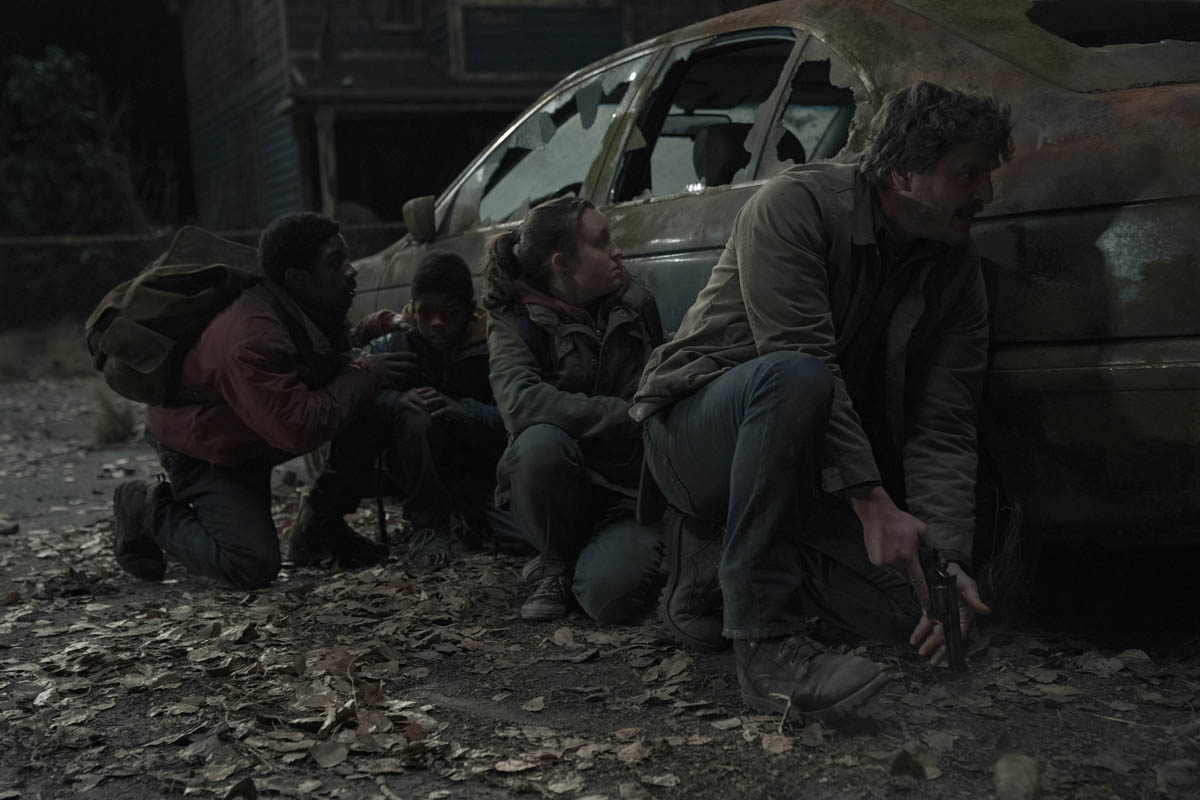
I think I saw behind-the-scenes — it might have been episode five — that seemed like it was all 3D, where the truck goes through the ground and the infected come pouring up out of the crater.
GOOD: That was a great one. That CGI truck that went all the way under and then the infected coming out was actually a combination because again, they're so good at this.
They understand that a combination of real people and digital characters is what gives the sense of realism, that there are real textures that are interacting with fake textures.
Those fake textures then blend in and you see the reality of it all. Some of those creatures were created to have more speed and velocity than the actual human beings that were in full prosthetics. That was a series of background extras in full prosthetics that were rushing out of that hole.
It was crazy. They did that moment many, many times and I was amazed that nobody really got hurt. But they were always about safety there, so that's why I'm sure nobody got hurt.
MENDEZ: The mixture of them using prosthetics a lot of the time really helps. Like the scene in “Left Behind” when Ellie and Riley are attacked by the infected, that's a guy. He had prosthetics on. He was pretty scary before they even touched anything on him.
We had our actors reacting to normally real things. I think that made a difference. It helped with the edit too to be able to see these infected characters right there. So really, for the most part, we had visual effects helping us in that regard.

But there is a scene in “Left Behind” where we did have to picture what was happening and that was when Ellie goes into the mall and the lights are not on yet and then she is looking out and that shot of the mall coming to life, that is just Bella Ramsey standing in front of a blue screen.
That was one where our visual effects team had to really fill in everything for us. In the edit when I was able to cut that scene, the way that we got that working was, I started with sound. What does it sound like when the mall's coming to life? In order to time that scene, I started with the big, heavy metal turning on and we did this cool, little rhythmic thing with that.
Then, we had Alex working directly with us on the visual effects and he and Luke were getting us these passes of the temp mall coming to life. That was definitely one where we did have to use our imaginations a little bit and use the help of sound and Bella's reaction to get us in the right place for that.
I love the idea that you mentioned that you started with sound. I've even heard from the VFX guys that the sound helps them like that. They say, “Oh, I can work. This gives me something to work with.”
MENDEZ: Yeah, exactly. We had that sound in from the very beginning and then Craig worked closely with them to get it exactly how he wanted, but the sound was the one of the first things for that that we had.
GOOD: It definitely allowed them to figure out how the picture was going to be adjusted and how they could feel that the lights were turning on in sequence once you had done that. The way they did it, the way they turned around on Ellie, they had practical lights that were replicating that.

We were able to look at the way that they were turning on in her eyeballs and see how that was happening.
As an audience, you're thinking, “Oh, this has gotta be a dangerous, scary place.” But it's being presented as, “Hey, we're all safe here. It'll be fun.”
Talk to me about what it took to build the tension in that scene leading up to what is gonna happen. Then, Tim can maybe follow up with an episode of his where he had to build that kind of tension.
MENDEZ: This is a fun one. In “Left Behind,” we have that scene where we see the infected come to life, right? After that point, you know that he's gonna be lurking or attacking them at some point.
What's great about what Tim and I decided to do is we continued to just cut normally as we would because the thing is our characters don't know that that guy has woken up or is anywhere.
We felt it was best to just continue cutting it the way that we would normally cut it because Ellie and Riley are in their own world. It's for us to stick with our character kind of approach, it’s not doing anything about leading the audience to see that the infected is gonna come at any point.
We just basically are continuing to approach it as we normally would. As far as building tension, once you see that infected come to life, you as an audience member know it could happen, but again, we're not gonna give you much more until it actually happens. I think that was a fun way to do that.
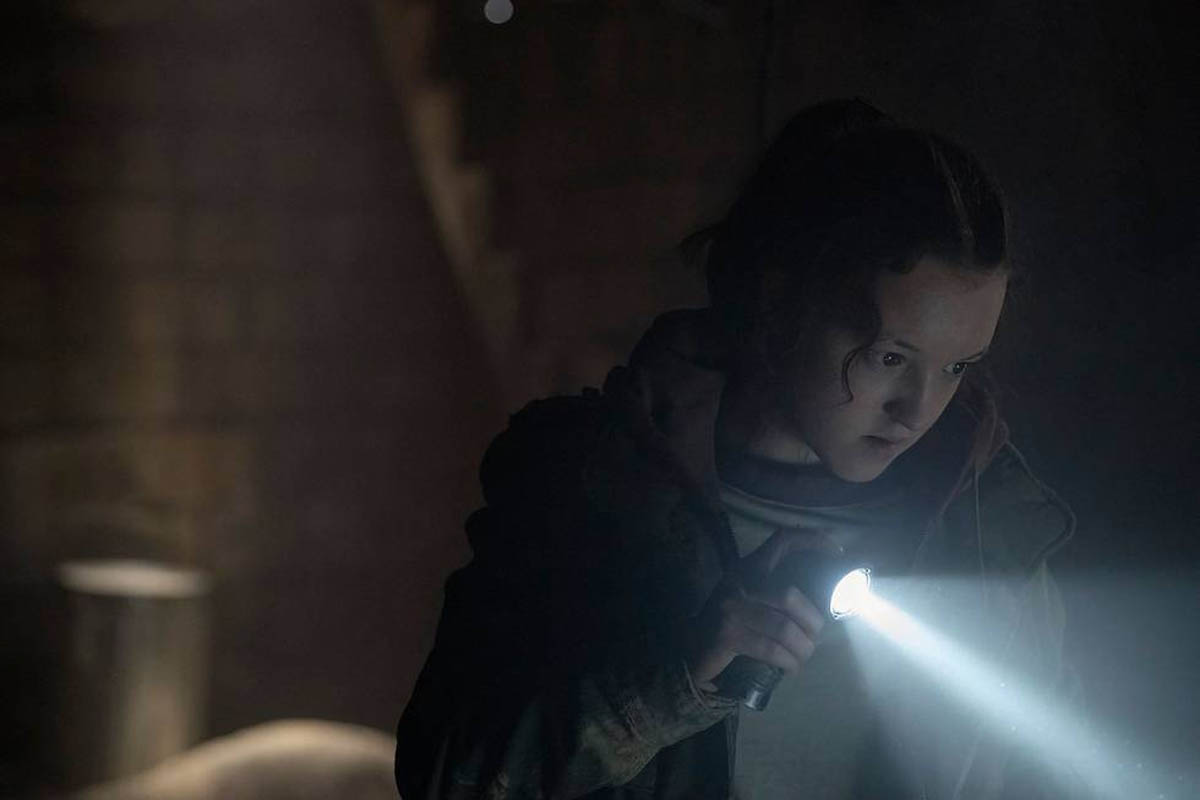
Was that shot of the infected guy coming to life in the place that it was in the script?
MENDEZ: It's where it is scripted because the idea is that they're playing in this arcade and they're being very loud and they're screaming and they're excited. Their noises are drifting down this hallway and it wa awakens this infected. That is the idea. It's where it was scripted.
Then, obviously, when you’re dealing with setting up the infected guy, you're also dealing with the sound of it being part of the story.
MENDEZ: Definitely. When he wakes up, Tim had done a temp, like a big, deep breath of the infected waking up, which we had in there for a while and it's not in there anymore. But it was good to get the feeling of this big intake of breath and we pitched it down so he sounded really creepy.
That was kind of how we started temping in the feeling of the infected waking up.
GOOD: Otherwise, Tim is not creepy. Trust me. He had to be pitched down, although my work still lives on in “Left Behind” because I am the photo booth bunny and that is my voice.
MENDEZ: We got Tim's voice into the photo booth scene pretty early on and it just stuck. Then, they decided to keep it and it's in there to this day and it makes me laugh every time I see that scene because it's Tim. It's just Tim pitched up as a bunny.
Tim, any thoughts on building tension and when you choose to put in a shot that sets the audience up so that they're always on edge?
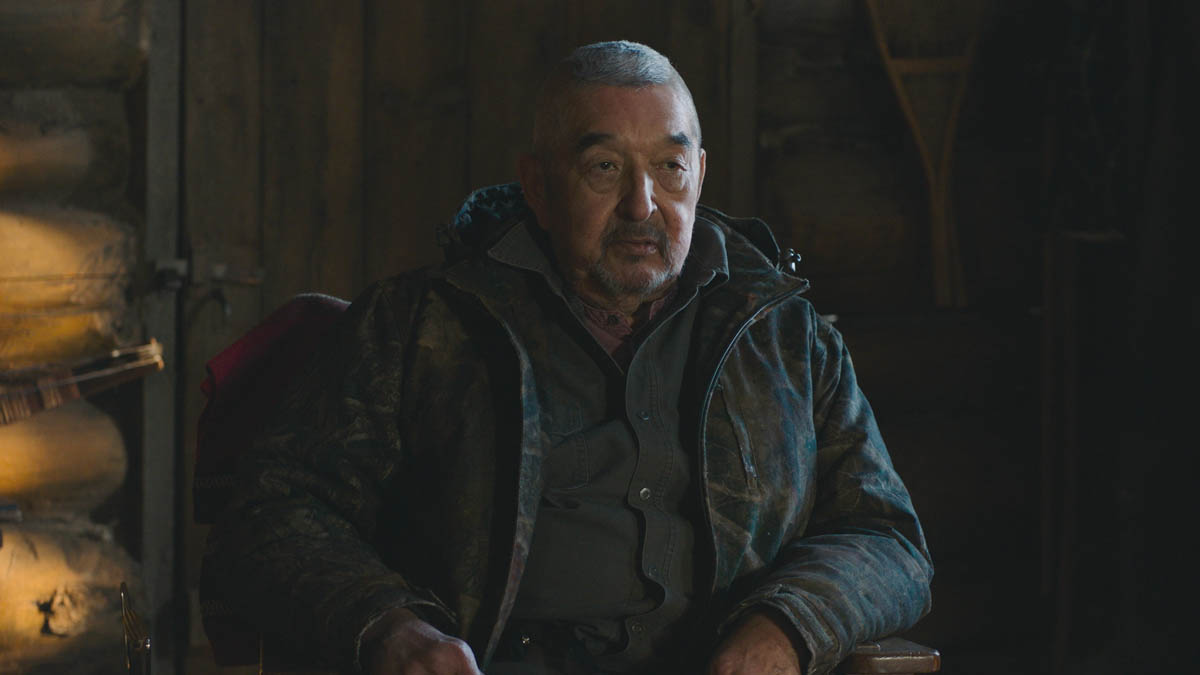
GOOD: I have a specific instance and it's in episode four. There's a sequence where Joel and Ellie have crashed into this laundromat and they've been attacked by these two guys. There's a sequence where the two guys have been taken out at this point.
But what they didn't know is that there was another kid who was behind the building. He catches Joel off guard and Joel is attacked by him and he's about to die. Then Ellie has to use a weapon for the very first time, we think. The audience thinks. I loved doing that sequence for tension.
I absolutely loved it because a lot of what I love with tension is not allowing the audience to see certain things. You're not going to get to see this. You are not going to get to see what's happening with Joel. You're gonna have to live with what's happening with Ellie.
It completely dovetails into this idea that if you're playing with the character, then you're experiencing what the character is experiencing and you're not breaking out of that “give the audience an omniscient perspective of what's going on.”
So in that sequence, I remember very clearly the fun part of it was number one, when one of the guys comes in and Joel has to shoot him, we never showed the guy or Joel shooting. We only showed Ellie terrified that she was gonna be caught.
I love that because again, we had all the footage that we could have used to show what happened logically, that this guy came over here, he came over there, Joel shot him from here, and then he goes down.
But instead, by sticking with just Ellie, you felt an enormous amount of worry ‘cause you don't know where the guy is and you have no idea what's gonna happen. Even the shot, when it happens, I remember saying for a second, “Who just got shot?” ‘Cause you don't know until it's revealed.

The other guy’s on the ground, Joel's the one who fired successfully. Then, when the other guy bounces in, you are then stuck with Ellie and she has to go rescue him because she doesn't know what's going on with Joel. All she can do is hear. I wanted to prevent the audience from seeing what's happening with Joel so that they could feel the tension of being with Ellie.
I broke that only one time because there was a moment when I really had to understand that there was a real threat to Joel's life. There was a really great shot of Pedro being strangled. I said, “It's a threat to character, so it still works.” My rule was always, if it's about the character or a threat to the character, then those shots are functional and I'm using them.
But in that specific instance, it was great to play everything from Ellie's perspective. You were never with any other characters because again, it prevented the audience from having any kind of comfort as to knowing what was going on. That's how I love to play with tension in that way. I like to prevent the audience from always knowing what's going on.
Because again, if they know what's going on, if they could even predict for one second what's about to happen because they've seen something that the other character who you're supposed to be following has not seen, then it doesn't work. You've blown it. I think that that sequence is one of my favorite sequences because of the tension it creates in the audience by withholding their ability to see what's going on.
I've only seen the show through once and I remember that scene. What I remember is not at all what actually happens. My memory is of Ellie and her fear of what's going on and “am I gonna be left alone forever? Am I gonna be discovered? Am I gonna be found?”
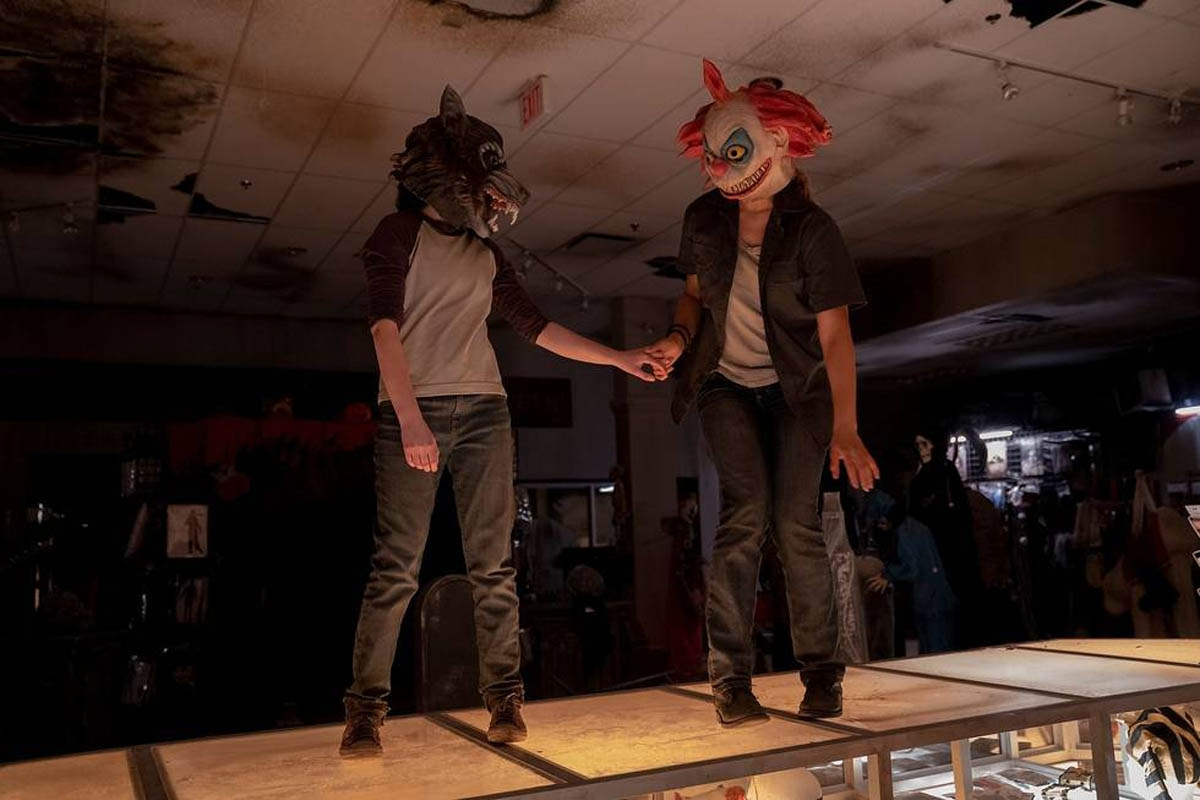
GOOD: If that's what you're thinking, then we are doing alright.
Emily, can you think of any scenes where you used character perspective, where maybe you could have shown something outside of a character's perspective, but you chose to play this scene from one character?
MENDEZ: There was a scene I had cut in episode three where Ellie finds a gun in Frank's little dresser in Bill and Frank's house. Originally, when I had cut that scene, you see she looks into this drawer and she sees the gun right before she picks it up.
Tim said, “Well, what if we do the scene where she looks in the drawer, she sees something, but we don't see what she sees yet?” When I recut it this way, it started this whole thing where we started to call it “mini mysteries.” Tim has always done this, but we started calling it mini mysteries at this point.
Basically, it’s this idea that a character can see something, but you might not see what they see initially because it's this mini mystery. So the moment that I'm thinking of is, later on in “Left Behind,” Ellie and Riley have just had this talk about Riley leaving with the Fireflies.
Riley says she's got one more thing for Ellie. Then, Riley gets up and she walks away. We had plenty of footage to show what she's doing. She's going over and she's grabbing masks. But I stayed with Ellie in my initial cut because I felt that the point of view we wanted to stay with was Ellie’s.
We wanted to see her kind of taking in that her friend is leaving because it just emotionally felt that was where we needed to be. Then, we have Riley say, “Hey,” and she throws her this mask. So you don't see this mask, you don't know what Riley's doing. You're with Ellie. So we're sticking with her.

Then, this mask arrives and Ellie catches it. Then, what's kind of cool is this mask is a very iconic mask from the game. You get that surprise, but also dealing with the mini mystery of, “What's Riley doing over there?” I think that sometimes, that's a cool way to deal with the scene.
Tim has taught me that these mini mysteries really do pay off because you kind of get your audience thinking, “Huh? What's happening over there? Oh, what is that? Is that a mask? It's the mask from the game.” That's just an example of one of those moments.
GOOD: It's like a five-second mystery. That's the best part about it. It doesn't have to last long, but that's the beauty of it, that for five seconds the audience is going, “What is that?” Then, you don't tease them for too long.
“What's in the drawer?”
GOOD: “What's in that drawer?” Exactly. “Oh, it's the gun.”
I want to ask, Tim, since we already know Emily was a huge fan of the game. Tim, did you know anything about this game and did you decide to play it during or before you started editing it?
GOOD: I didn't know much, honestly. It was a weird thing because again, I got the job late and I’m thinking, I don't even have time to even play this game because it's on a PlayStation, which I don't have, and you can't get 'em. They're impossible to get. So there was just like no way I was gonna do it.
Then, I remembered, I had a job a decade ago for Bad Robot and one of the producers over there said, “Don't know too much.” I said, “Well, wait, you don't want me to read the scripts?” He said, “No, don't read the scripts.”

Because if you know what's gonna happen, then you're going to wait for it to happen. Then, you're gonna know what's happening. So maybe it's better that you know as little as possible because then when you approach everything that comes into your brain and into your process, there is nothing attached to it.
You're just gonna put it together in a way that you think is the best. You're gonna be able to know if something's working or if something's not because you have no preconceived ideas about what it is. I said, “That's not a bad risk.” I kept thinking also that, because I don't play video games, there's gonna be a lot of people like me who aren't gonna know this.
I said, “There has to be an ambassador for that person.” I'm happy to do that. I think what happened was I just wasn't — I know this seems silly, but I wasn't as nervous about living up to the game because I didn't know what the game was.
Luckily, Emily knows the game. She would say, “Yeah, this is good. You're doing good.” She would make sure that there were little things she would adjust. She’d say, “This you're gonna wanna pay attention to!” I’d say, “Okay, great. Tell me a little bit about that.”
She would. Craig would do the same. He’d say, “Ah, I like what you did except here, I want you to pay attention to this.”
Can you think of any examples of those things other than the mask that Emily just mentioned?
GOOD: I got a couple of examples for you. In the third episode, Ellie and Joel are packing to go away. They're packing the truck up and they're just randomly putting some clothes together.
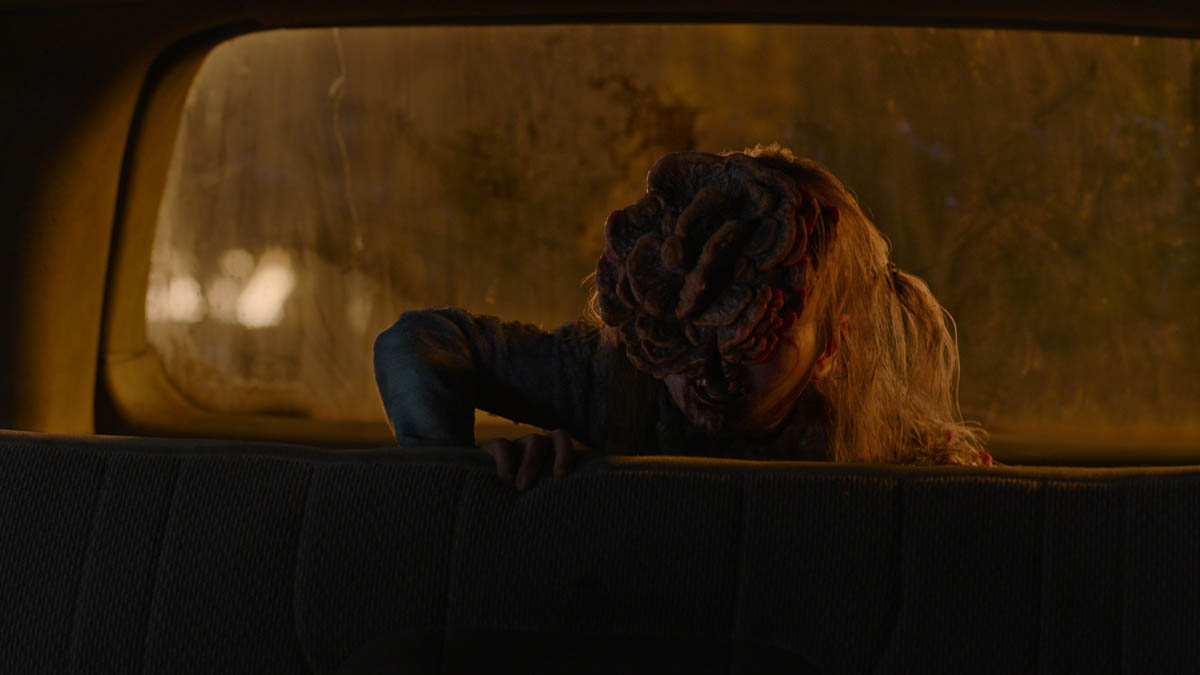
We had so much different coverage of things that they're putting away. They were putting away cans. They're putting away whiskey. They were putting away toilet paper. Then, Emily just saw this red shirt coming out of a women's clothing thing and she says, “Tim, that shirt is critical and it's gonna be a great little mini mystery for our little friends who played the game because they're gonna know that this red shirt is the iconic shirt that she wears for the second part of the story.”
If we just show the back of it — you can't even see the front, you just see the color, she looks at it, and then puts it in the bag — they're gonna go nuts. Then, later on, when you reveal her in the shirt, they're gonna say, “That's the shirt.” There was a little moment where she says, “If there's anything we have to keep in this montage, it's that because that is a critical little moment for keeping in the game.”
MENDEZ: In the same episode, episode three, when Joel and Ellie are going into a gas station and Ellie runs up to the Mortal Combat game, she says, “I had a friend that knew everything about this game.” I said to Tim, “You know what she's talking about, right?” He said, “Of course not.” I said, “She's talking about Riley who's super important and will be coming up later.”
GOOD: He says, “So make sure you do something special over here and make sure it means something. Don't just offer it up to cut because who cares about this arcade game?”
MENDEZ: These were good little details that I was able to talk to Tim. We were able to get in there early that Neil and Craig would've gotten these in there eventually, but I think it just helped our pipeline to have those in there early on in the cuts that Tim and I were turning in.
GOOD: It made them very happy to know that we were thinking about these things that they had meticulously designed.
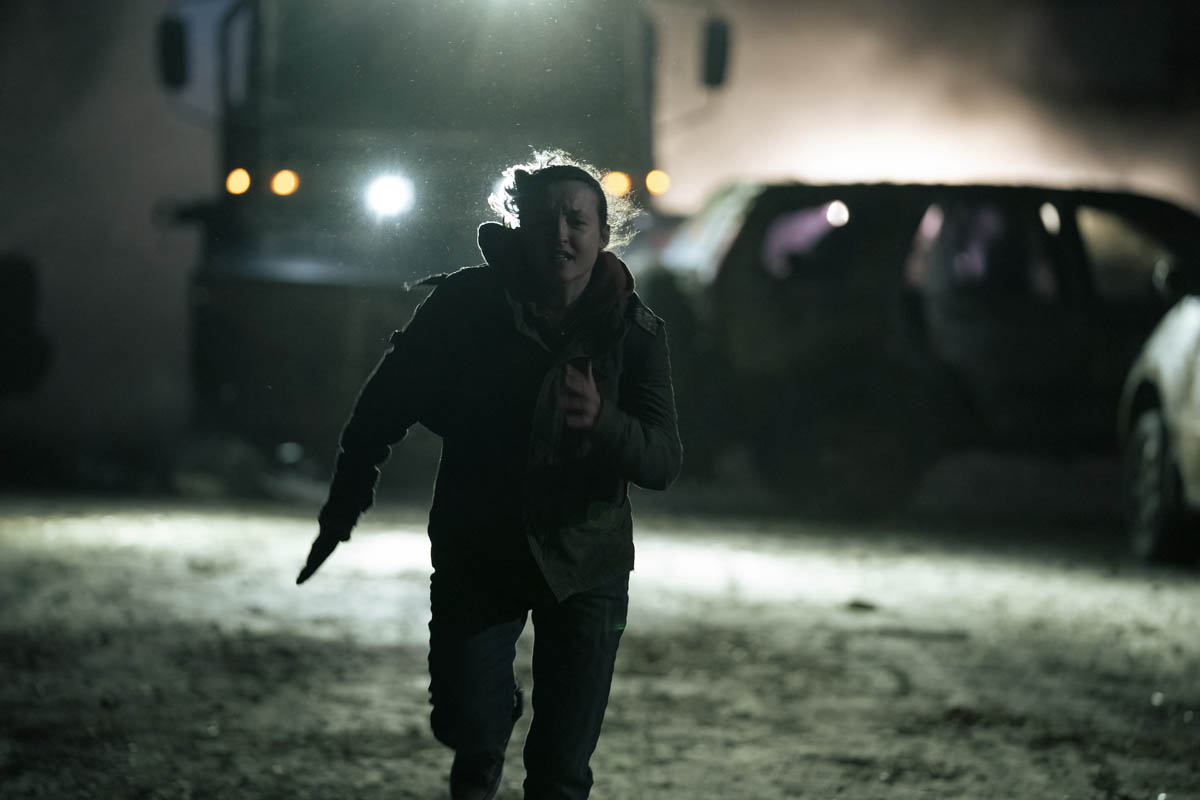
I love the idea that you mentioned with the shirt, your angle on the shirt, because with some of those reveals, I would think, it's important not just that they happen, but that you're on a certain angle or that you reveal it or there's emotion like the Mortal Combat arcade game.
How do you show that game to make it so it seems special?
GOOD: I think for me, once I knew it was special, I liked teasing it, just a hair. I would use a shot where it's being framed on the side as though it's an over-the-shoulder of the game.
So the people that really know it, they’ve seen something that you’re not gonna reveal.
GOOD: Exactly. Then, I waited just a hair ‘cause I went back to Pedro ‘cause I'm just giving them a little bit of little rope to wait to see it. Then, it cuts around and you see Mortal Combat and you say, “That's the game.”
Then, I specifically wanted to show her using the controls because later on, you see how important it was that she learned how to use the controls from Riley.
These are little things that I always like to say, if people decide to go back and watch theories again, they're gonna see these little details that we put in early on that are gonna pay off later, but only on a second viewing. I usually go up to 17 viewings. I always say, “On the 17th time, people might notice this.”
Sometimes, I've seen people see things 17 times. They'll say, “I've seen this like 17 times.” I’ll say, “Okay, cool. Then did you see all the things I put in there for you? ‘Cause on the 17th time, you better have seen this thing ‘cause I really laid it out there for you.”
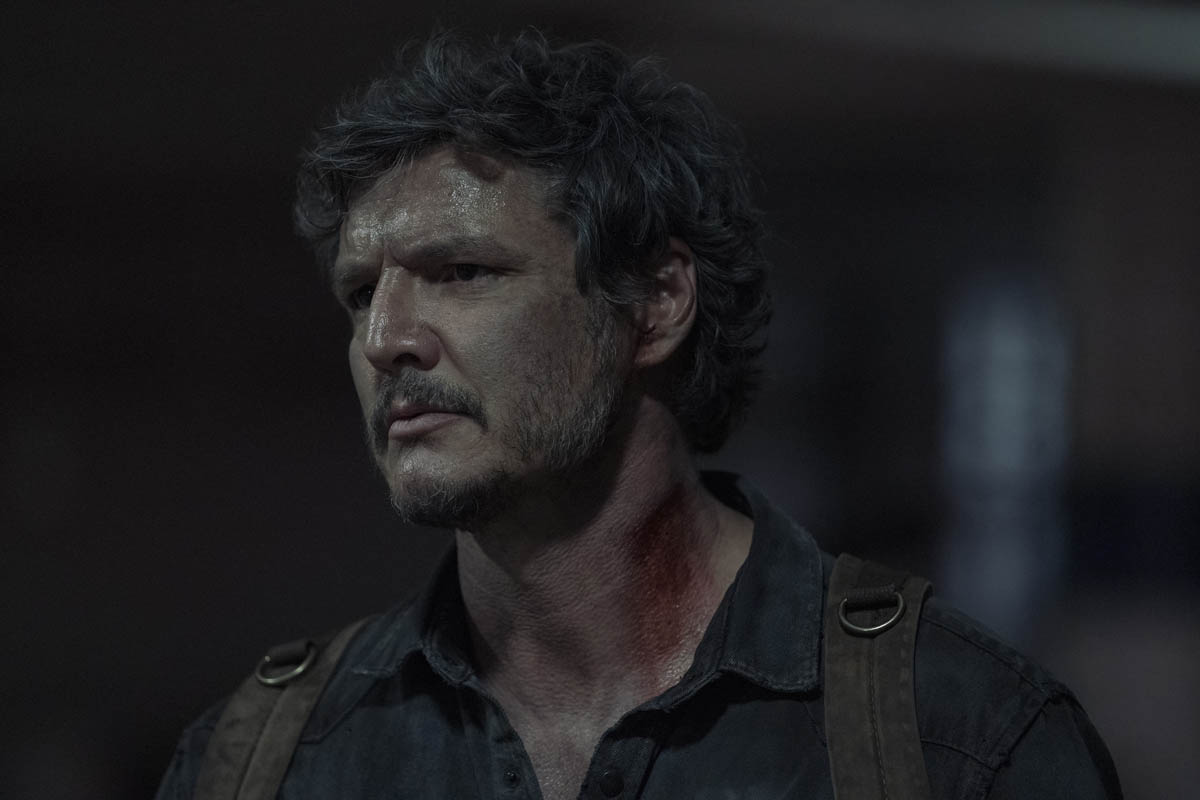
Is there anything else you two wanna chat about with either specific scenes or things that you really think are important that editors might be interested in knowing?
GOOD: I have one actually. It's an interesting one at the end of episode five. There was a long conversation between Ellie and Sam, who's the young, deaf boy. It was an almost six minute scene and it was a really difficult scene in my opinion because it's a scene where there's very little dialogue because he's deaf and so they literally can't speak and he has this magic slate that he's using to talk to her.
He has this little pen and lifts off the little Xerox carbon. We all had that when we were growing up. Well, at least, I did.
That was the best we had, but that was a tricky scene and editorially, I thought, this can get repetitive very quickly. It worried me because it was sort of the same thing happening over and over. How can I possibly, A, make this not feel repetitive, and B, make sure that it is emotionally working?
I saw a shot and it was later in the sequence where Ellie was silhouetted behind a light in a profile. I recognized when I was looking at that, it made me think of religious icons and saints and whatnot. It made me look at the story again and read the scene again and say, “You know what? I think the cinematographer and the director have hit on something here.”
Maybe inadvertently, maybe not, but she believes that she can save him because she has some sort of power that they have been telling her this whole time.
She believes then that she has this sort of saintly power that she can rescue this poor boy who's been infected and is probably going to turn into a full-on infected. She has this wonderful sequence with him, where she basically has to tell him, “I will promise you that you're gonna be okay. Here, look, my blood is medicine.”
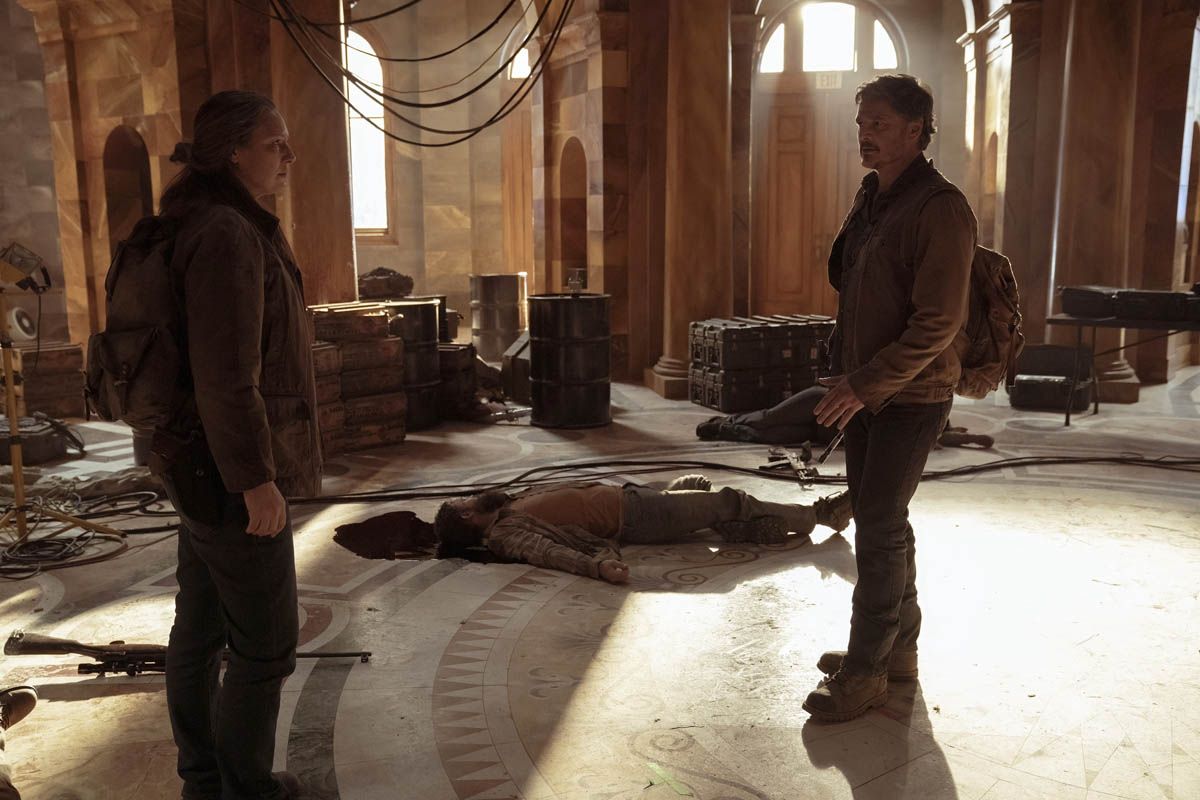
In doing so editorially, I tried to have a situation where every time they would speak via the magic slate, I'd never use the same tactic. I said, “Well, in this version of it, I want to see him watch writing and then to reveal the sign at the very end from his perspective.”
Then, in this version, I want to see what she's writing because I don't think it's as important for impact, so I can actually watch her write it down and then show his reaction to being shown the piece of material. The audience always knew what was happening, but it was always from a different perspective.
I think that's what made a six-minute dialogue scene without dialogue not feel repetitive. I'm really, really proud of how that scene turned out because again, I always go back to two-person scenes. I find those to be the most satisfying. I don't know what it is. I guess, in an action scene, things have to happen in a certain manner.
Not always, but in general, in a dialogue scene with two characters, anything is possible. When you can do it in such a way that hopefully the audience never feels like they're bored or they're always interested in what's happening or there's an emotional turn that happens, that sequence to me is right up there with some of the best things I've ever done.
Again, I understand that my audience is not just the audience out in the world, but the audience of editors, the audience of filmmakers who think, “Ah, look at that. They're just doing the same thing over and over again.”
There's a high degree of difficulty here when you want to impress the people in your field. This was one of those sequences where I feel like I really put it all out there for a six-minute dialogue scene. It had to be without music also.
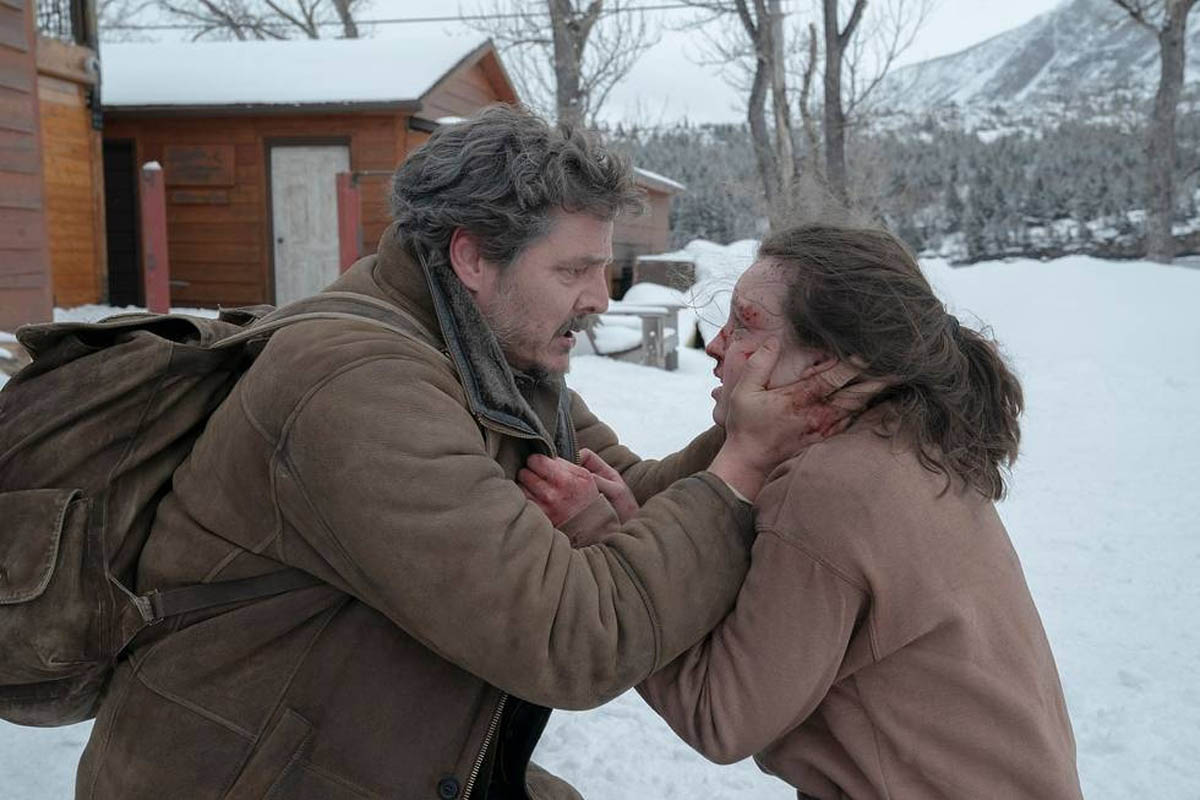
There was nothing that could guide you until the very end when she realized that or when she thought that she was promising him that she was gonna protect him. It was a risky thing and I'm super proud of how it turned out and super proud of how the end turned out, having no music for the sequence where the two brothers end up dying.
That was a really heart-wrenching scene to put together. I knew it couldn't have any music. There was no music required. That was too devastating to need any kind of commentary whatsoever. That's the sequence that I just really wanted to talk briefly about and thanks for giving me the opportunity to.
Emily, one of your scenes that you wanted to talk about that might be revealing of the craft or your hard work?
MENDEZ: I think for me, one of the more challenging scenes, but also one of my favorite scenes that I got to work on, is the scene where Anna gives birth to Ellie. But it's also not just the birth part. It's her running up to the farmhouse and running away from an infected. There were so many different things going on in that sequence, and first of all, it was the opening of the episode.
It's the opening, it's gotta catch us, but you have a horror element of her being chased by this infected, but then we also have this thing going on where she's giving birth, so we had to incorporate a lot of things into this scene while also not being too confusing.
We want people to know she's gonna give birth, she's being chased by an infected. I think, for me, just kind of weaving in these ideas of being scared, her giving birth, and also while hiding in this house was pretty difficult in a way. We also used a lot of sound in that sequence where she finally gets up to this top room and she's hiding from this infected woman who's been chasing her.
Throughout the scene, one thing that's really cool about the sound in that scene is you hear the infected voice, her screaming, and it's getting closer and closer slowly as we go on. She's closing in on Anna as Anna's trying to find a place to hide, so that was something we had temp in from the very beginning.
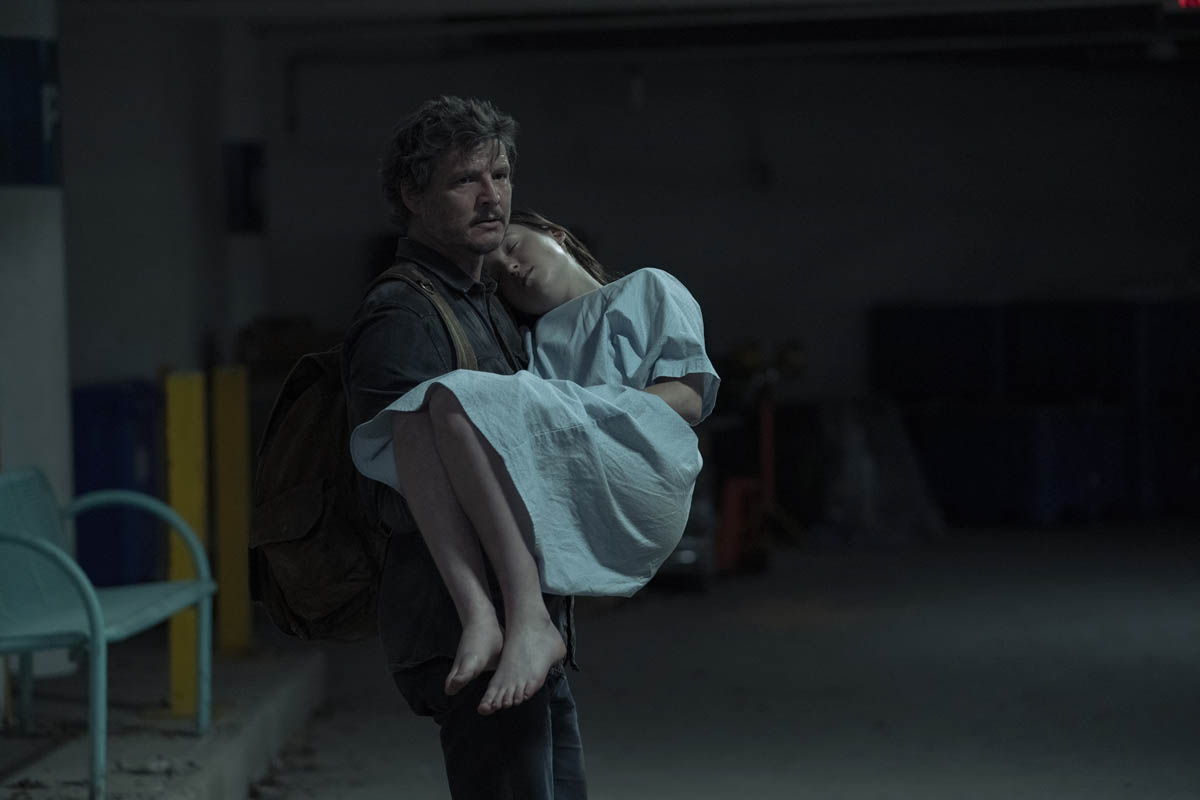
Then, once Anna is up in this room kind of hiding, you hear this infected break-in. All these sounds that we had to incorporate, all this temp sound design work that went into it, it was a lot of work, but it was one of my favorite scenes to work on just because you have that nice moment at the end, once she does give birth to Ellie, then you turn this scene that's this horrific scene into something that's then beautiful.
I got to touch on a lot of different genres of a scene and I think that was a great exercise for me to do and I'm very proud of that scene as well.
GOOD: You seamlessly executed those tonal transitions.
That’s what I was just about to say. It's the tonal transitions that are difficult there because it’s so scary, but you also have this amazing moment of birth that's the opposite, this motherly moment. It's so powerful.
MENDEZ: It was very powerful to work on. Even again watching the dailies, I was thinking, “This is just the best stuff ever to get to work on.” When you get to that part where you're in that little bubble with her and Ellie and you just feel that, it just is everything.
Do you guys ever get out of breath when you're cutting scene?
GOOD: All the time. Every day. Usually, I get out of breath a lot of times because I'm running around to different offices saying, “Hey, can you watch this? Can you watch this?”
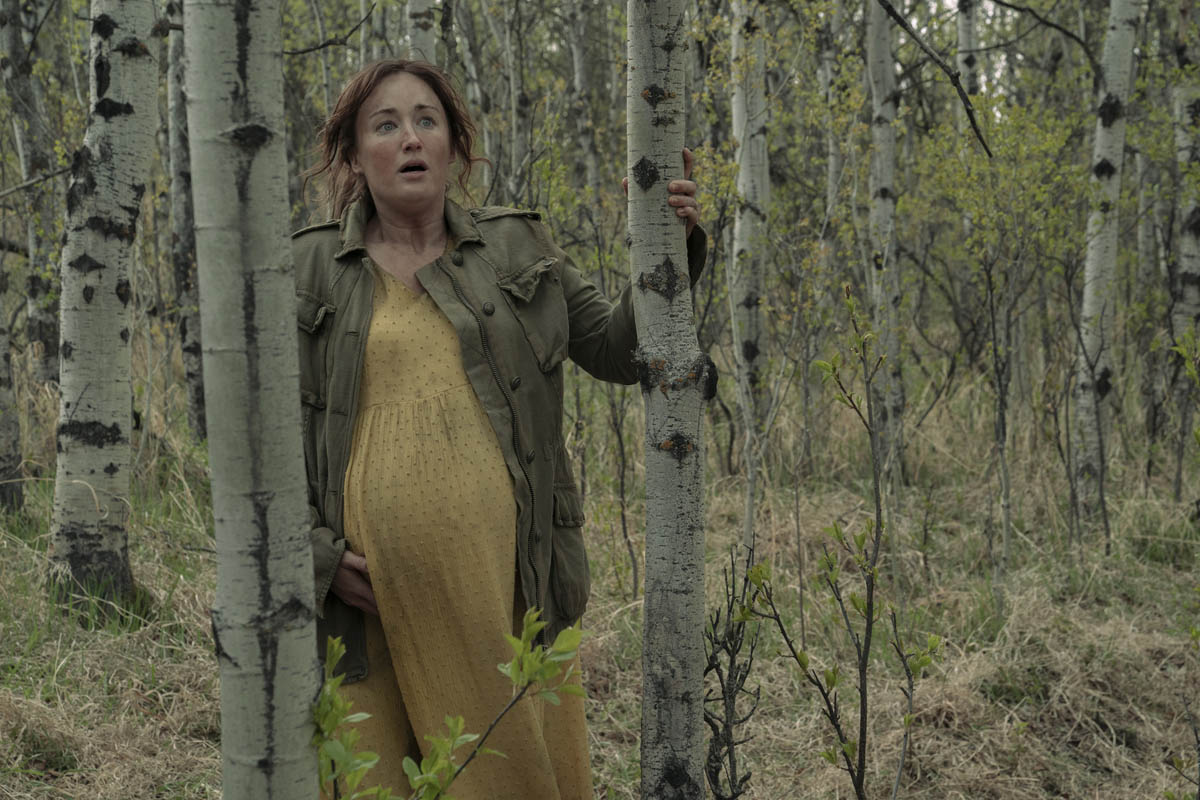
MENDEZ: I do too. The dailies and the storylines stick with me. I'll find myself going home and I just feel sometimes when we're working on these scenes that are really heavy or one of the characters has died, I actually feel emotional over these deaths of the characters in the show.
It's definitely something that sticks with me because these characters mean so much to me. When we were working on the show, I definitely felt affected by it even when I was going home.
GOOD: Hundred percent. I kept telling Craig, “Why do you have to keep killing all these people for? It's really hard for us.”
Do you feel like you need to do another show where people just go to a nice island and have fun for the whole time?
GOOD: Yeah, exactly! You think it would be a nice palate cleanser.
I just need somebody to sit in a hammock for a day and read a book.
GOOD: Right. Perfect.
It'd be a little boring to edit, but less stressful.
GOOD: That’s OK.
Emily and Tim, thank you so much for chatting with Art of the Cut today, and I really enjoyed hearing about everything that went into this show that I was definitely affected by, and I think many people were. Thank you.
MENDEZ: Thank you for having us.
GOOD: Thank you so much, Steve. Really appreciate it.
Go behind the scenes to see how Wylie Co. used Mocha Pro to tackle VFX on season 1.
